His Majesty King Bhumibol Adulyadej The Great
Chapter 16: His Majesty the King’s Genius in Governance (Political Science and Law), the Arts, and Sports
“One person who has the ability in a certain field is usually skilled only in that particular area, especially those with genius-level talent, who tend to excel in one domain… Scientists who make inventions are often blind in the arts, while those who develop the mind may be lacking in material development. Professors who are brilliant in social problems often do not understand the mechanisms even to the extent of changing a single light bulb… It is exceedingly rare to find someone who is a genius in both ‘science and the arts,’ and additionally possesses ‘governance’ skills, as exemplified by His Majesty the Head of State of Thailand.” (Suvicha, 1996: 45)
1. Royal Genius in Governance (Political Science and Law)
His Majesty King Bhumibol Adulyadej, the Ninth Monarch, was a sovereign of supreme virtue. He conducted Himself and carried out royal duties in accordance with the role of a monarch within a democratic system with utmost integrity and purity. He adhered to the royal legal and traditional frameworks, overcoming obstacles and challenges through tireless diligence and perseverance. His ultimate goal was to assist the nation and the Thai people, who faced political and economic difficulties, to become self-reliant.
The Parliamentary Library, Secretariat of the House of Representatives (1996: 25–26), provided details regarding the royal powers of the monarch as stipulated in the Constitution as follows:
“… Since the change from an absolute monarchy to a constitutional democracy with the King as Head of State in 1932, Thailand has had fifteen constitutions, each of which has consistently defined the royal powers of the monarch.
The Constitution of the Kingdom of Thailand, B.E. 2534, as amended by the Constitution (No. 5) B.E. 2538, stipulates that the King shall exercise sovereign powers over the Parliament, the Cabinet, and the Courts, as specified in Section 3.”
The King exercises sovereign power, which is the supreme authority in governing the country. This power serves as the fundamental framework for exercising all other powers under the Constitution and the longstanding royal legal traditions. Specifically:
- The royal power to confer noble titles and bestow royal decorations, as well as to revoke or withdraw them (Sections 9 and 183).
- The royal power to appoint the Privy Council (Section 10).
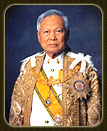
General Prem Tinsulanonda, President of the Privy Council
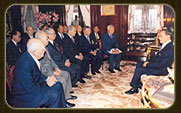
His Majesty graciously granted the current Privy Council the opportunity to pay a private audience at Phiab Suk Palace, Wang Klai Kangwon, on Friday, 15 August 2003.

Privy Council
Note:
Current Privy Council Members (from January 2004 – present):
- Gen. Prem Tinsulanonda – President of the Privy Council
- Mr. Chao Na Siwan – Privy Councillor
- Mr. Thanin Kraivichien – Privy Councillor
- Rear Admiral Mom Luang Atsani Pramoj – Privy Councillor
- Air Vice Marshal Kamthorn Sinthawanon – Privy Councillor
- Air Chief Marshal Sitthi Sewatshila – Privy Councillor
- Mr. Chulanop Snitwongse Na Ayudhya – Privy Councillor
- Mom Rajawongse Adulkit Kitiyakara – Privy Councillor (deceased)
Gen. Phichit Kullavanij – Privy Councillor
10. Mr. Ampol Senanarong – Privy Councillor
11. Mr. Chamras Khemajaru – Privy Councillor
12. Mom Luang Taweesin Lada-van – Privy Councillor
13. Mom Rajawongse Thep Thewgul – Privy Councillor
14. Mr. Sakda Mokkamarkkul – Privy Councillor
15. Mr. Kasem Wattanachai – Privy Councillor
16. Mr. Plakorn Suwannarat – Privy Councillor
17. Mr. Sawat Wattanayakorn – Privy Councillor
18. Gen. Surayud Chulanont – Privy Councillor
(Privy Council, 2004: 21)
3. The royal power to appoint the Regent (Section 16)
4. The royal power to amend the Palace Law on the Succession to the Throne, B.E. 2467 (Section 20)
5. The royal power to promulgate draft Acts as laws, with the advice and consent of the Parliament (Section 93)
6. The royal power to withhold assent to a draft Act by not giving the royal signature or returning it (Section 94)
7. The royal power to appoint members of the Senate (Sections 100, 101)
8. The royal power to issue Royal Decrees for general elections (Section 117)
9. The royal power to dissolve the House of Representatives (Section 118)
10. The royal power to appoint the leader of the opposition in the House of Representatives (Section 122)
11. The royal power to appoint the President and Vice-President of the Senate and the House of Representatives (Section 125)
12. The royal power to convene Parliament, open and close parliamentary sessions, and extend the session period (Sections 134, 135)
13. The royal power to convene an extraordinary session of Parliament (Section 136)
14. The royal power to appoint the Parliamentary Auditor (Section 162 bis)
15. The royal power to appoint the Prime Minister and Ministers (Section 163)
16. The royal power to relieve Ministers from office upon the advice of the Prime Minister (Section 174)
17. The royal power to promulgate Royal Decrees upon the advice of the Cabinet (Section 175)
18. The royal power to promulgate Royal Decrees related to taxation (Section 177)
19. The royal power to issue Royal Decrees not contrary to the law (Section 178)
20. The royal power to declare and lift martial law (Section 179)
21. The royal power to declare war with the approval of Parliament (Section 180)
22. The royal power to enter into peace treaties, armistices, and other agreements with foreign states or international organizations (Section 181)
23. The royal power to grant pardons (Section 182)
24. The royal power to appoint and remove military and civil officials, including Secretaries and Directors-General (Section 184)
25. The royal power to authorize the judiciary to adjudicate cases in the royal name (Section 186)
26. The royal power to appoint and remove judges in the courts of justice (Section 192)
27. The royal power to appoint and remove judges in the administrative courts (Section 195 bis)
(From Thai Parliament under the Royal Patronage: 50 Years of Reign, 1996: 25-26)
It can be seen that, within the framework of a constitutional monarchy, the monarch normally does not have overlapping roles in government administration. However, His Majesty King Bhumibol Adulyadej succeeded as the “Advisor of the Nation,” always placing the welfare and happiness of the people as the highest priority (Bureau of Universities, 1996: 36-38).

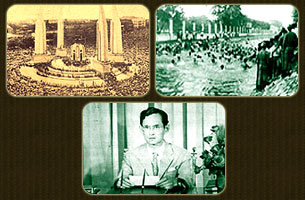
The Event of October 16, 1976
King Rama IX conducted himself and adapted to the shifting political circumstances that were bound to occur during the early stages of the democratic system, as if upholding the fragile Thai nation in the palm of his hand.
This strength and stability, derived from His Majesty’s patience, together with His royal benevolence, allowed social and political changes during His reign to occur without the violence and disasters that befell other nations (1996: 24). This is evident in the crises of October 16, 1976, and May 1992 (The Thai Parliament under the Royal Benevolence: 50 Years of His Reign, 1996: 83–92).
At first, students gathered to demand that the government arrange for Field Marshal Thanom Kittikachorn to leave the country and to bring to justice those responsible for the hanging and killing of students without delay. However, Village Scouts and various political factions organized counter-protests against the students and attempted to storm Thammasat University, resulting in armed clashes. The police entered the university to clear the area, joined by the Red Gaurs, Village Scouts, and Nawaphon groups; some entered the campus, while others waited outside to attack students fleeing from the police. The situation descended into chaos, causing numerous injuries and fatalities among the students. The National Administrative Reform Council, led by Admiral Sangad Chaloryu, then seized power in order to resolve the crisis swiftly and ensure national stability. They later had an audience with His Majesty King Bhumibol Adulyadej the Great to report on the situation. Order gradually returned, and His Majesty graciously appointed Mr. Thanin Kraivichien as Prime Minister.
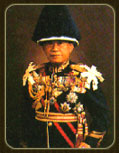
Field Marshal Thanom Kittikachorn

Mr. Thanin Kraivichien
In order to restore the situation to normalcy as swiftly as possible, the confusion and disorder were quickly resolved, halting further bloodshed and loss. This was by virtue of the royal grace of His Majesty King Bhumibol Adulyadej the Great, whose exalted virtues commanded respect and reverence, and who served as the enduring center of faith and loyalty for the Thai people. His royal benevolence shielded the nation, dispelled the dangers of the crisis, and guided the country back to peace, stability, and prosperity.
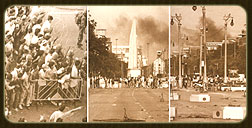
The May 1992 Crisis
The second incident in 1992 occurred when the National Peacekeeping Council, led by General Suchinda Kraprayoon with General Sunthorn Kongsompong, seized control of the government from Prime Minister Chatichai Choonhavan and declared martial law, prohibiting gatherings of more than ten people. Later, when a new election produced no party with a majority to form a government, five parties—the Chart Thai Party, Thai Citizens’ Party, Social Action Party, People’s Party, and Samakkhi Tham Party—supported General Suchinda Kraprayoon as Prime Minister. This appointment was widely rejected because General Suchinda had not been elected by the people. Fifteen Ramkhamhaeng University students who protested were arrested. Flight Lieutenant Chalard Worachat staged a hunger strike in front of the parliament to demand a prime minister elected by the people. Major General Chamlong Srimuang also declared a hunger strike but later canceled it, resigned as head of the Palang Dharma Party, and continued protesting the appointment of a prime minister who had not been elected.
Subsequently, demonstrators and citizens attending the debates marched from Sanam Luang to the Government House but were stopped at Phan Fa Bridge. Some individuals threw objects at the police and set fire to the Golden Mount Fire Station and the Juvenile Protection Division. Police attempted to disperse the crowd but were unsuccessful, as the demonstrators continued to gather and increase in number, and on May 17
The Ministry of Interior approved the arrest of seven individuals for gathering in groups of ten or more. On May 18, Major General Chamlong Srimuang was detained at the Bangkhen Metropolitan Police School on charges of assembling a group of ten or more and causing public disorder. A state of emergency was subsequently declared in Bangkok, Samut Prakan, Nonthaburi, Pathum Thani, and Samut Sakhon. The situation escalated when military forces used weapons to disperse the crowds, resulting in numerous injuries and fatalities among the demonstrators. Reports of the dispersal were not only broadcast within the country but also reached international audiences, as foreign journalists covered the violent crackdown on protesters on television in several countries.
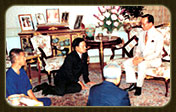
On May 20, 1992, at 9:30 p.m., His Majesty King Bhumibol Adulyadej the Great graciously granted the opportunity for Mr. Sanan Thammasak, President of the Privy Council, and General Prem Tinsulanonda, Privy Councillor and statesman, to accompany Prime Minister General Suchinda Kraprayoon and former Palang Dharma Party leader Major General Chamlong Srimuang in an audience at Chitralada Royal Residence. On this occasion, His Majesty delivered a royal address instructing General Suchinda and Major General Chamlong, as representatives of their respective factions, to work together to resolve the crisis by facing each other and restoring the nation, with Mr. Sanan Thammasak and General Prem Tinsulanonda providing guidance and counsel in a neutral capacity. His Majesty also offered admonitions to both leaders to guide them in resolving the situation.
Today’s problem is not an issue of drafting or amending the constitution, but rather the safety and morale of the people. Therefore, I urge you, especially the two of you, General Suchinda Kraprayoon and Major General Chamlong Srimuang, to work together by facing each other and not confronting one another, for our country belongs to everyone. Confrontation brings only danger and loss; each side will be defeated, and the greatest defeat will be that of the nation.
Therefore, I request that both of you come together—not to confront one another, but to face each other. You represent the opposing sides and are called upon to help resolve the current crisis of violence. Once this situation has been addressed, you may discuss and consult on how Thailand can be restored and developed. This is the reason for summoning both of you, and I trust that you understand your role in rebuilding the nation from its ruins, which will bring greater personal fulfillment through doing good.
By virtue of His Majesty’s royal grace and profound wisdom, the violent events within the country, which affected national prestige, disrupted the economy, and disturbed the peace and well-being of the people, were brought to an end. The nation was restored to normalcy, albeit amid a somber atmosphere caused by bloodshed and national division.
Given that the royal guidance graciously provided on May 20, 1992, holds great value for all citizens in considering whether any action will benefit the common good, it is presented here for reflection and consideration.
Royal guidance
His Majesty King Bhumibol Adulyadej the Great
Graciously provided
At Chitralada Royal Residence, Dusit Palace
On Wednesday, May 20, 1992, at 9:30 p.m.
- It should not be surprising that you were invited to meet in this manner, for everyone is aware of how chaotic the situation had become and how it could have led the nation to collapse. What may seem unusual is why General Suchinda Kraprayoon and Major General Chamlong Srimuang were specifically invited, as there could have been other key figures involved. They were chosen because, from the very beginning of the events, these two individuals were directly confronting each other, and ultimately, as the conflict expanded, it was appropriate to summon them.
At the outset of the confrontation, the objectives of both sides were fairly clear, but after more than ten days, it became evident that the nature of the confrontation had changed significantly. Regardless of the outcome, losses were inevitable, including substantial casualties and injuries, as well as extensive material damage to both government property and private assets. Moreover, there were immeasurable impacts on the national psyche and economy. If the situation were allowed to continue, whatever the reasons or origins, Thailand would face collapse, and the nation that had been carefully built over many years would be rendered meaningless or largely detrimental, which was already beginning to manifest. Therefore, it was necessary to identify conflicts and address them systematically, for the current problems over the past few days were no longer merely political or related to official positions, but issues threatening the very survival of the nation, and thus required collective resolution.
Many individuals submitted recommendations for resolving the situation—hundreds of suggestions came from both within Thailand and abroad. The proposals ranged widely; initially, some advised resolving the matter by dissolving the parliament, which was discussed with all eleven political parties. The majority responded that dissolution was unnecessary, with only one supporting it, and so that proposal was dismissed. Other petitions and recommendations were offered, suggesting various approaches. These were forwarded to the Cabinet or the Prime Minister’s Office for consideration, but they could not be implemented as proposed. Alternatives included dissolving the parliament or amending the constitution to achieve the intended objectives, meaning those objectives that had sparked the confrontation in the first place.
In fact, this method was previously addressed on December 4, 1991, before several thousand members of an association, and it seemed to be well received, as the reasoning presented was considered a feasible solution. At that time, it was emphasized that either “amend first, enact later” or “enact first, amend later” could work, which everyone understood as referring to the constitution. Constitutional amendments had been ongoing, improving upon previous versions. Before speaking at Dusidalai Hall, General Suchinda had agreed that the constitution could be enacted and subsequently amended gradually to align with democratic principles. This process had been discussed for several months. The rationale for enacting the constitution, even if incomplete, was that it was of sufficient quality, better than the interim constitution used for nearly a year, as certain provisions of the interim constitution were harmful and inadequate for governance. Thus, if the plan discussed on December 4 were followed, it would be a return to addressing prior issues, not the present ones.
Today’s problem is not one of drafting or amending the constitution, but concerns the safety and morale of the people. Currently, citizens across the country are anxious about potential dangers and fear the nation’s collapse, making resolution difficult. According to reports from abroad, sons and daughters residing overseas are aware of the situation and have attempted to inform those in the country that Thailand can still resolve the crisis, though such hopes may be somewhat optimistic. Therefore, I urge you, especially General Suchinda and Major General Chamlong, to work together by facing each other rather than confronting one another. The country belongs to all, not just one or two individuals. Cooperation, not confrontation, is required to address the danger. When people act violently in a state of frenzy, they lose awareness, fighting without purpose, aiming only to dominate. No one truly wins; confrontation brings only defeat, and the greatest loss is that of the nation. The people are the population of the entire country, not just those in Bangkok. If Bangkok is damaged, the entire nation suffers, and there is no value in claiming victory atop ruins.
Therefore, I request that both of you come together—not to confront each other, but to face each other. You represent the opposing sides, not merely two parties, and are called upon to resolve the present crisis of violence. Once this situation has been addressed, you may discuss and consult on how Thailand can be rebuilt and restored. This is the reason for summoning both of you, and I trust that you understand your role in reconstructing the nation from the ruins, bringing personal fulfillment through doing good. The following observations are offered for consideration.
The President of the Privy Council and Privy Councillor Prem are senior statesmen, ready to provide guidance and counsel with impartiality and love for the nation, in order to lead the country toward development. I entrust them with the task of helping to build the nation.
List of individuals granted an audience
To receive the royal guidance of His Majesty King Bhumibol Adulyadej the Great
On Wednesday, May 20, 1992, at 9:30 p.m.
At Chitralada Royal Residence, Dusit Palace
- Mr. Sanan Thammasak, President of the Privy Council
- General Prem Tinsulanonda, Privy Councillor
- General Suchinda Kraprayoon, Prime Minister
- Major General Chamlong Srimuang, Member of Parliament, Bangkok
(from The Thai Parliament under the Royal Benevolence: 50 Years of His Reign, 1996: 93–95)

Mr. Sanan Thammasak

General Prem Tinsulanonda

General Suchinda Kraprayoon

Major General Chamlong Srimuang
In addition to His Majesty King Bhumibol Adulyadej the Great’s patience, royal benevolence, and boundless compassion, His Majesty also possessed a heart overflowing with justice. When petitions were presented, He would carefully examine the merits of each case, as noted by M.L. Thawisan Ladawan, regarding His Majesty’s benevolence toward prisoners, which demonstrated His exceptional insight in political science, governance, and law, as well as His commitment to justice (1996: 27–28), as follows.
“…Another aspect of His Majesty’s royal benevolence was directed not at the general Thai populace, but toward a specific group of individuals who had suffered misfortune—namely, prisoners serving sentences who submitted petitions. After the government reviewed these petitions, they were carefully presented to the Privy Council and then submitted to His Majesty for royal consideration under the constitutional powers vested in Him. I wish to convey that His Majesty took these matters very seriously, reading every word of the petitions or case documents. In many cases, it is difficult to explain whether it was due to His extraordinary intellect or exceptional wisdom, but it resulted in some prisoners being granted a chance to rebuild their lives and receive the justice they were entitled to as Thai citizens. One case occurred in Chiang Rai, involving a farmer with five children who was traveling to a merit-making event (thot pha pa) and requested to ride on a friend’s bicycle. On the return journey, officers briefly stopped them at Chiang Saen District, but allowed them to proceed. Later, the prisoner was arrested for alleged conspiracy to commit murder with other prisoners. He maintained his innocence, claiming he had only attended the merit-making event, and during the trial, a fellow prisoner amended his testimony to confirm that none of the three individuals were involved in any killings, and that they had merely been traveling to purchase a bicycle.”
This was stated that the matter had already been discussed with the court officials, and there would be no punishment, and the case would be dismissed. However, by unfortunate circumstances, the court initially sentenced him to life imprisonment, which was later reduced to one-third, resulting in 33 years of imprisonment. He received royal pardons twice, reducing the sentence to 19 years. Having already served 4 years, he had the opportunity to submit a petition. His Majesty carefully examined the content of the petition, which was extensive, and, with His exceptional wisdom and insight—what could be described as a “sixth sense”—He assessed the situation accurately.
His Majesty then instructed the Royal Secretary to send officials to investigate whether the prisoner had truly committed the offense, as doubts remained. Investigations were conducted across multiple connected prisons, and the facts were clearly established: the prisoner had merely been riding on a bicycle and had no involvement in the crime, exactly as stated in the petition. His Majesty then graciously granted royal clemency, releasing the prisoner. This example demonstrates that, through His wisdom and compassion, His Majesty restored the prisoner to a normal life with his family, allowing him to be a support for his five children. This is just one case, among many, in which His Majesty examined petitions thoroughly and meticulously.
The benevolence of His Majesty the King toward His subjects resembles that of a father caring gently for his children. As praised, “… He possesses a heart full of compassion; upon receiving information from the people, He studies the problems and seeks ways to help, giving direction and continuously monitoring the situation. When subjects are granted audiences, they have confidence in His compassion and openly present their problems without concealment. He is the refuge of the poor in times of suffering and the pillar of the people when the nation faces adversity …” (The Thai Parliament under the Royal Benevolence: 50 Years of His Reign, 1996: 74)
2. The Royal Genius in the Arts
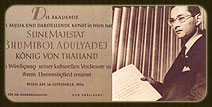
All forms of art by His Majesty King Rama IX have been recognized at the level of a professional artist and are highly esteemed both domestically and internationally. On 5 October 1964, the Music and Arts Academy of Vienna, Austria, conferred upon Him an honorary membership, ranking Him as the 23rd member of the Academy, making Him the first monarch to receive such an honor.
In 1965, Silpakorn University conferred upon His Majesty King Rama IX an honorary Doctorate in Painting, bringing joy to Thai artists everywhere. Later, in 1986, the National Culture Commission bestowed upon Him the title of “Supreme Artist,” the highest honor ever granted, aptly recognizing His Majesty’s extraordinary skill across all branches of the visual arts (University Bureau, 1996: 598–599).
2.1 Oil Painting (Hand-Painted Works)
His Majesty King Rama IX began studying painting while residing in Switzerland between 1937 and 1945, pursuing his studies independently. He personally visited art galleries and museums, and acquired art textbooks for self-study. He began seriously creating oil paintings around 1959 and continued until 1967. After that, His Majesty’s royal duties increased, leaving less time for oil painting; nevertheless, He produced more than 100 works.
His Majesty King Rama IX had a profound understanding of the meaning and significance of art, as reflected in the royal remarks He delivered during the opening of the 15th National Art Exhibition in 1964, in which He stated:
“… Thai art has flourished since ancient times and can truly express the character of our nation because our ancestors created it with genuine sincerity. I urge all artists to preserve this invaluable sincerity and hold it as the core principle in creating your works of art going forward …”
In the field of painting, His Majesty King Rama IX took a keen interest in modern art and engaged in dialogues with contemporary artists, both Thai and foreign. In 1964, He visited the studio of the world-renowned Austrian painter Oskar Kokoschka in Montreux, Switzerland, exchanging ideas with him. Kokoschka was known for his expressive use of bold colors and vigorous brushwork in the Expressionist style, which His Majesty greatly admired. As M.C. Kanvik Chakrabandh, an expert art and photography critic, wrote, this exemplifies the royal genius of His Majesty in the realm of painting.
“His Majesty the King created paintings of remarkable interest … His brushwork is exquisite and lifelike. Such realistic painting can be likened to using the full refinement of royal language—graceful and polished—but it may not fully convey the artist’s emotions onto the canvas. Those who paint beautifully and realistically often do not express personal thoughts or feelings. His Majesty employed unusual compositions and bold, warm colors tending toward abstraction (Abstract), yet He subtly embedded emotions and symbols that one could discern His intended meaning. His oil paintings rarely depict objects realistically; instead, they express feelings, ideas, or certain actions.”

Mom Chao Kanvik Chakrabandh
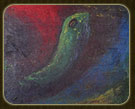
The painting “Vatta” (Evolution)
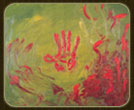
The painting “Red Hand”
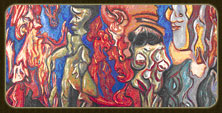
The painting “Yu Yae”
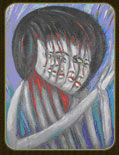
The painting “Dual Personality”
For example, the painting “Yu Yai” shows bright red flames; when one’s gaze sweeps across it, a creature-like form appears, without a defined shape, but with a green face, shiny black eyes, and a red mouth, satisfied with its actions. This painting has not been exhibited but serves as an excellent example. Similarly, “Dual Personality,” “Evolution,” and “Red Hand” (Wilas Maneewat, 2000: 83–86).
His Majesty King Bhumibol Adulyadej graciously allowed Thai artists to have close audiences with Him. Among the Thai artists who had the opportunity to meet Him during that period were Hem Vejkorn, Khian Yimsiri, Phaitoon Muangsombun, Fue Hariphitak, Thawee Nuntakwang, Uab Sanasen, Chulatas Payakharanon, and Piriya Krairerk. He frequently inquired, “Is it acceptable?” However, since His Majesty’s paintings were inherently creative and reflected His unique personality, no Thai artist offered direct advice, except for consultations on color techniques.
Thawee Nuntakwang remarked on the King’s painting work: “From my perspective, all the artists were astonished by His Majesty’s artistic talent. His application of theory, the proper spatial composition, and the tasteful narrative are all exceptional. Everyone revered Him as a genius. I know that His Majesty’s interest and love for this branch of art is no less than for any other field, and He has pursued it for a long time, contrary to the belief that He only recently became interested. … He could critique paintings, identifying their style—whether abstract, cubist, realist, impressionist, etc.—with accuracy and ease, and He possessed remarkable memory to notice how an artist’s work had evolved from previous years. … His Majesty had countless duties: visiting border police units, checking on wounded soldiers, meeting hill tribe people … climbing large mountains … wherever the view was beautiful, He would stop to sketch. I observed that He loves nature, favors large trees and vine-laden forests, and cares deeply about their preservation.” (Wilas Maneewat, 2000: 89–94)
Although His Majesty graciously allowed Thai painters to offer advice on His work, He maintained a distinct personal style, never directly adopting anyone else’s approach. Therefore, the paintings of King Bhumibol Adulyadej exhibit a focus on internal emotional expression and are largely aligned with abstract art, as noted by M.C. Karawik Chakraphan earlier (Office of the University Council, 1996: 594).
Therefore, the study of His Majesty the King’s painting approach shows that He did not begin with theoretical frameworks or follow a systematic sequence from one style to another. Rather, His work depended entirely on His interest and inclination. Once He decided to paint, He would do so immediately according to His feelings. Over nearly a decade, His paintings explored a variety of styles. He did not work continuously in one style for a long period; instead, whenever He wished to paint in a particular style at any given time, He would do so immediately. For example, He painted portraits at various periods, created dreamlike or emotional works at several intervals, and produced abstract pieces concurrently during different times. Professor Phisanu Suphanimit remarked, “His Majesty’s paintings can be categorized into groups according to modes of expression,” which are:
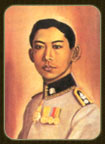
The painting “สมเด็จพระราชบิดา” (“His Royal Father”)
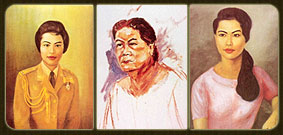
(3) “สมเด็จพระบรมราชินีนาถ” (“Her Majesty the Queen”)
(4) “ไม่มีชื่อ” (“Untitled”)
(5) “เขียนที่ภูพิงค์” (“Painted at Phuping”)
Realistic Portraits – These are portraits of people close to the King. Some were drawn from photographs (e.g., No. 1: His Majesty the King’s Father), while others were drawn from life, such as Her Majesty the Queen, the Royal Princesses, M.L. Bua Kitiyakara, and members of the royal household.
These realistic works include studies of facial structure, light and shadow, and color application (Nos. 1, 2, 3, 4, 5).
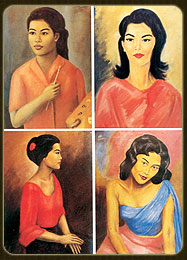
6. “Chop Kian”
7. “Her Majesty the Queen”
8. “Thai Rose”
9. “Her Majesty the Queen”
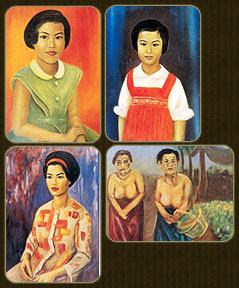
10. “Her Royal Highness Princess Sirindhorn Thepparat Suda”
11. “Her Royal Highness Princess Sirindhorn Thepparat Suda”
12. “Her Majesty the Queen”
13. “Going to the market”
Another set consists of portrait paintings with a uniquely creative character, in which He used bold colors to emphasize the emotion of each painting differently—for example, some are gentle, some bright, and some intense (paintings numbered 6, 7, 8, 9, 10, 11, 12, 13). The finest works in this series include the Phuping painting (No. 5), “Chop Kian” (No. 6), Her Majesty the Queen (No. 9), and Her Royal Highness Princess Sirindhorn Thepparat Suda (Nos. 10, 11).
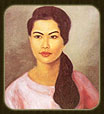
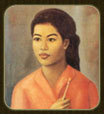
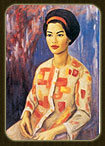
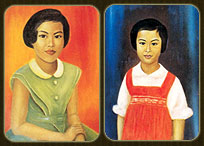
The Phuping painting was created in 1962 when He moved to reside at Phuping Palace, Chiang Mai. He painted this work with a soft and gentle atmosphere, using contrasting light and dark tones without employing strong or heavy brushstrokes. The posture of Her Majesty (the model) is defined through harmoniously interwoven lines, while the background features soft gray tones, and the light pink attire emphasizes a tender and gentle mood.
The painting Chop Kian was created in the same year. It depicts Her Majesty the Queen as a painter, with a focused posture—holding a brush in her right hand and a palette in her left. The composition appears strong and stable, and the color scheme conveys a sense of solidity and seriousness, using a dark green background contrasted with her orange attire.
The painting of Her Majesty the Queen (No. 12) was created with a joyful mood, emphasizing the Queen with a dark blue background that makes her figure stand out. She also playfully added orange accents to her patterned attire.
The other two equally valuable paintings are of Her Royal Highness Princess Sirindhorn (Nos. 10 and 11), created in 1962. One depicts her seated and the other standing, expressing the model’s innocence and purity in her youth. The paintings do not use anatomical theory or light-and-shadow techniques but are drawn simply, with bold contrasting color schemes—for example, a green outfit against an orange background and a red outfit against a blue background. This use of color evokes the works of post-impressionist painters such as Vincent van Gogh and Paul Gauguin.
2. Portraits Emphasizing Personal Emotion The paintings in this set were created by using the structure of the human face merely as a starting point. The King employed his imagination to modify the forms according to the emotions and feelings he wished to convey.
Some paintings were restructured, combining different elements according to the meaning the King intended. Thus, the works in this set were not created as realistic portraits but focused on conveying emotion and significance.
The paintings in this set (Numbers 14, 15, 16, 17, 18, 19, 20, 21, 22, 23, 24) each stand out individually, making it impossible to select a single best work.
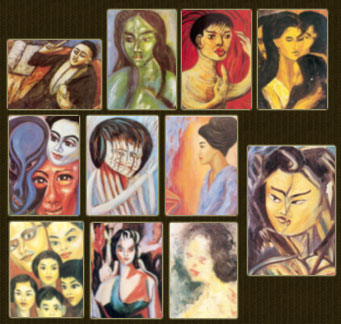
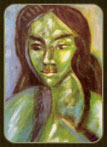
Untitled painting (Number 15) – He painted the face in dark green with bold, vigorous brushstrokes. The focus was not on the beauty of the subject but on conveying a heavy and tense emotion.
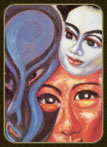
Untitled painting (Number 16) – He altered the facial features to have varied forms; some faces are elongated like wisps of smoke, while others resemble people wearing masks.
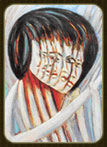
Untitled painting (Number 17) – He painted side-profile faces layered together to appear as if in motion, intriguingly experimenting in a manner reminiscent of the French Futurist painters.
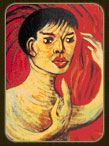
“Fight” (Number 18) – He expressed intense combat emotions through shapes and colors.
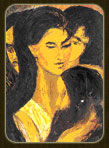
Untitled painting (No. 19) is believed to have been created by Her Majesty the Queen, depicting Her Majesty surrounded by Their Royal Highnesses the three Royal Children. The painting conveys the love and warmth of family. If it were to be given a title, it might be called Mother and Child.
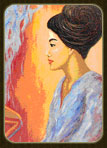
The portrait of Her Majesty the Queen (No. 20) is another beautiful depiction of Her Majesty. However, it is distinguished by the emotional depth imparted to the painting, making it more than a simple likeness. It portrays Her Majesty playing the piano with the passionate intensity of a musician, expressed through flame-like strokes rising from the instrument.
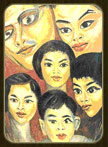
Untitled painting (No. 21) depicts Her Majesty’s own family. The large portraits of His Majesty the King and Her Majesty the Queen are placed above, with the portrait of His Royal Highness the Crown Prince in the center, and below surrounded by the portraits of Their Royal Highnesses the three Royal Children. The composition reflects Her Majesty’s distinctive style, in which the faces are connected and arranged together rather than positioned as if posing for a photograph.
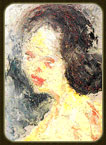
Untitled painting (No. 23) portrays the face of a woman, created in a moment of sudden inspiration and completed within only a few minutes. It is regarded as one of the most beautiful works. This method of painting follows the same approach as that of the Impressionist and Expressionist artists, who created their works with swift emotion and expressed only what they truly felt.
3. Analytical Figurative Paintings in the Cubist Style The paintings in this series reflect Her Majesty’s application of the Cubist theory, which analyzes spatial dimensions by constructing angular forms through intersecting straight lines. The human figure serves as the foundation, including both bodily and nude forms. Yet, in every painting, traces of the original human subjects previously portrayed by Her Majesty remain visible. (Paintings No. 24, 25, 26, 27, 28)
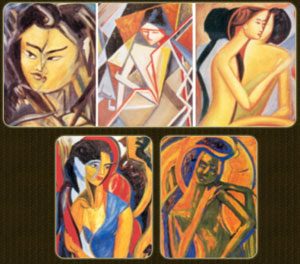
4. Paintings in the Style of New Form Creation This series of paintings was developed from Her Majesty’s previous works that employed the analytical theory of Cubist art. Through this progression, Her Majesty discovered a new approach to creating forms freely and distinctively. The works emphasize beauty, harmony, and unity in composition, without relying on narrative or emotional expression. They represent a pure form of artistic creation, based solely on the visual elements of art. (Paintings No. 29, 30, 31, 32)
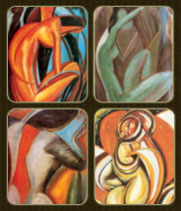
5. Imaginative, Dreamlike, and Surreal Paintings Most of these paintings can be considered works in which Her Majesty employed the freest use of imagination and dreamlike emotion. They are creations not bound by any artistic rules or theories, expressing Her Majesty’s unique personality in a truly individual manner.
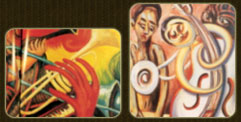
The Music Series (Paintings No. 33, 34) features musical instruments and musicians arranged together, conveying a sense of freedom reminiscent of the jazz music favored by Her Majesty. The composition is deliberately chaotic, with sharp intersecting lines, and Her Majesty employs intense, unrestrained colors without any moderation.
Untitled painting (No. 35) evokes a dreamlike feeling, resembling a young woman asleep and seeing a large floating eye in her dream. It conveys a surreal, frighteningly dreamlike atmosphere.
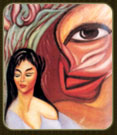
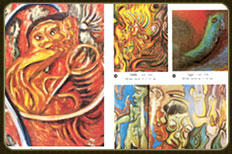
The four untitled paintings (No. 37, 40, 41, 42) appear to be the most striking works in this series. In these paintings, Her Majesty no longer focused on conventional beauty. They were created from the passionate depths of Her heart, conveying a sense of awe and fear. Everything in the images is distorted, with some parts missing or floating in emptiness. The colors are heavy and intense, with raw green contrasting against vivid red and bright yellow. Meanwhile, the painting Vatta (No. 41) evokes a feeling of a spirit slowly drifting and moving through space.
These paintings, expressing intense and mysterious emotions, are almost unbelievable as works created by a monarch residing in a royal palace. The creation of such paintings may have been inspired by Her Majesty’s visits to people in remote and impoverished areas, where She witnessed the hardships of the populace. These experiences were kept in the depths of Her heart, and when manifested in Her paintings, they directly reveal what lies within, depicting suffering as if the figures are trapped in hell, pleading desperately for help.
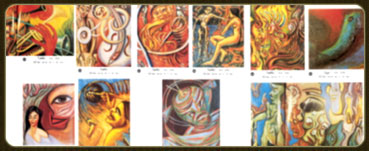
The paintings in this series are thus works that faithfully express what lies within Her Majesty’s heart. They are considered among the most valuable creations. (Paintings No. 33, 34, 35, 36, 37, 38, 39, 40, 41, 42)
6. Free Abstract Paintings The paintings in this series reflect Her Majesty’s free imagination, without any intention of using figurative forms. Colors are applied spontaneously, guided solely by emotion and feeling, expressing the true abstract states that reside in Her Majesty’s heart. (Paintings No. 43, 44, 45, 46)
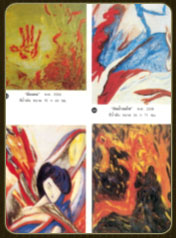
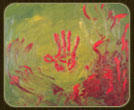
Red Hand (Painting No. 43) was created in 1961 while Her Majesty was suffering from a high fever. She experimented with this painting based on the sensations she experienced during her illness, exploring how it might appear once she had recovered.
Earth, Water, Air, Fire (Painting No. 44) was created in 1965. Her Majesty intended to express the abstract qualities of the four elements by using colors that convey continuous movement, reflecting the dynamic nature of earth, water, air, and fire.
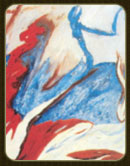
“The six approaches to Her Majesty’s paintings, as described above, show that the creation of each work did not follow a linear progression from one style to another. Instead, multiple styles were explored simultaneously. At times, after working in one style, a considerable period would pass before returning to work in the same style again.
The creative process demonstrated in these works reflects Her Majesty’s genius and freedom, showing that She was not an artist bound to any particular method. This approach results in paintings with a unique personality that is entirely Her own, embodying the true practice of a professional artist” (Office of the Higher Education Commission, 1996: 594–598).
Mom Chao Kawika Chakraphan wrote:
“Paintings serve as mirrors reflecting the temperament, mind, and character of the artist. His Majesty the King’s oil paintings reveal careful observation of the surroundings and attentiveness to events both around Him and across the Kingdom, as well as thorough knowledge of the world. They show thoughtful and profound consideration, direct and intense feeling, all controlled and restrained (these strong colors are often bounded by gray or black lines).” (Wilas Maneewat, 2000: 88–89)
His Majesty King Rama IX and Her Majesty Queen Sirikit, the Queen Mother, presided over the opening of the 13th National Art Exhibition in 1962 to encourage artists working in modern styles. Their Majesties graciously contributed Her Majesty’s paintings to participate in the National Art Exhibition every year from 1962 to the present, reflecting a boundless royal generosity toward the arts and artists.
อัจฉริยะพระเลิศล้ำ ลือไกล
ฉ่ำชื่นพระกรุณลัย ส่อง หล้า
ประมวลภาพพัฒนาไผท ทวยราษฎร์ เทิดแล
บุญที่ได้เป็นข้า อยู่ใต้ บทศรี
(Kunying Kulsap Kasemnaenkij, Author)
2.2 Photography Arts
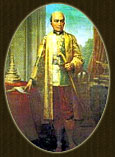
King Phra Buddha Loetla Nabhalai
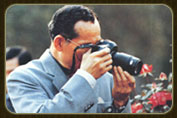
His Majesty King Bhumibol Adulyadej the Great
There are two Principal Artists of the Chakri Dynasty: King Phra Buddha Loetla Nabhalai (Rama II) and His Majesty King Bhumibol Adulyadej the Great (Rama IX). Both possessed expertise in numerous artistic disciplines. His Majesty King Rama IX demonstrated exceptional skill in areas such as music, painting, sculpture, architecture, decorative arts, and more. Among these, photography was a particular passion, which He applied in royal duties from childhood onward. At the age of eight (around 1936), He acquired His first camera, a small Coronet Midget, perfectly suited to His hands.
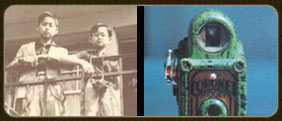
His Majesty began taking photographs from a young age. He sometimes developed and printed the images Himself, personally organizing them into albums. He recorded the dates—day, month, and year—on each photograph, maintaining this practice from childhood to the present. (Phungchit Supamit, 2004: 85)
Subsequently, He experimented with various types of cameras, some of which He purchased with His own funds, without insisting on always using the latest model. Over time, many camera manufacturers released new models to the market, and several companies presented cameras and photographic equipment to His Majesty on different auspicious occasions. His Majesty King Bhumibol Adulyadej tested each of these thoroughly (Poon Kasemchamras, 1992: 36).
Wilas Maneewat (1996: 86) noted that Mom Chao Kawika Chakraphan wrote about His Majesty the King: “Due to increasing royal duties, His Majesty has not had time to paint in oil for a long period; however, He has continued to photograph consistently. The King uses the standard lens that comes with the camera and is a Purist, especially when photographing Her Majesty the Queen and the Royal Children.”
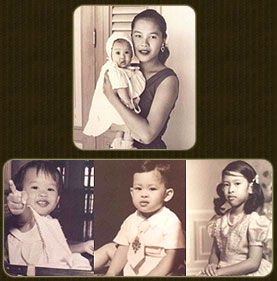
He photographed Her Majesty the Queen and the Royal Children.
Later, royal duties required Him to photograph only during official visits, especially to provinces and border areas. These were spontaneous shots taken in a single moment, relying on intuition, with no time for post-capture cropping or trimming. In previous years, the photographs His Majesty presented for exhibition serve as excellent examples of images taken “as is,” without alteration or enhancement in the darkroom. This approach is likened to a master chef who refuses to use MSG, believing that the quality of a dish should be judged solely by the ingredients and skillful preparation. Among these are images of His Majesty observing young royals, portraits of Her Majesty the Queen taken with a single household light, and photographs of impoverished children along the roadside, captured from a moving car before the children could even realize who the photographer was.
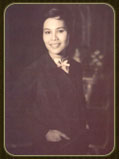
Portrait of Her Majesty the Queen, taken with a single household light.
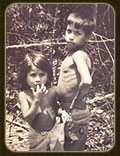
Photograph of impoverished children standing by the roadside.
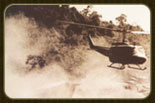
Helicopter
This year, the photograph was taken from a helicopter, showing another helicopter taking off from a hazardous area. The composition features a diagonal mountain ridge resembling a lightning strike, with a large cloud of dust swirling toward the ascending helicopter, as if a giant hand were reaching to seize it. This evokes concern in the viewer about whether the helicopter will make it safely. Although the image is in black and white, without strong colors to intensify the effect, it conveys a sense that the photographer was deeply involved with the scene (involvement). Unlike photographers who create postcards and focus on the aesthetic beauty of landscapes, photojournalists capture immediate, vivid moments that communicate the emotions and experiences of fellow human beings.
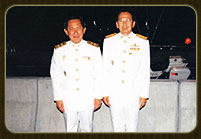
A photograph by His Majesty the King, graciously capturing Mr. Srisuk Chantrangsu, Director-General of the Department of Highways, on the Borommaratchachonnani elevated expressway, taken on April 21, 1998, at approximately 8:20 p.m.
His Majesty King Bhumibol Adulyadej, like King Chulalongkorn, photographed landscapes and scenes encountered during royal visits to the people in various areas. These included images of places, the citizens who came to pay respects, and beautiful natural scenery. In the field of development, His Majesty’s photographs played a vital role. For example, they documented interesting terrain, areas suitable for building dams, weirs, and reservoirs, village locations, and transportation routes, captured both from the ground and while aboard airplanes or helicopters. Such images could be used to support royal development projects. After project completion, He sometimes photographed the responsible officials with their work. These photographs served as evidence for efficient planning and timely response to national events. During the Bangkok floods, for instance, His Majesty photographed key locations from a helicopter to aid in assessment and preventive planning. These works were often spontaneous shots, captured in a single moment without time to arrange the angle. Yet, through His Majesty’s expertise, the photographs are clear, beautifully composed, and properly exposed.

All of His Majesty King Bhumibol Adulyadej’s photographs demonstrate that He did not take pictures solely for artistic purposes. His photographs reflect His deep interest in the lives of the people and His concern for their welfare. They could be used to plan and develop the nation’s social and economic well-being, bringing peace and prosperity, and supporting the Thai people to live good and fulfilling lives (Sakda Siripan, 1996: 254–255).
His Majesty’s generosity toward the field of photography is also remarkable
He graciously bestowed royal patronage on the Photographic Society of Thailand in 1959 and has supported the Society ever since. Beginning in 1962, He presented honorary trophies to winners of monochrome photography competitions and has attended the Society’s annual exhibitions to open the events and personally award winners in various photography categories. Furthermore, He contributed His own photographs for the Society’s exhibitions, allowing the public to admire and appreciate His exceptional skill in photography.
Regarding journalism, Ms. Jeerapa Onruang recounted that His Majesty showed great interest in the work of reporters and photographers. He advised that photographers should also be able to write news, so that the work could be done efficiently without needing two separate people.
His Majesty’s photographs graciously bestowed for exhibition, including:
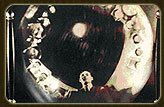
Photograph 1
In the Embrace
On September 12, 1962, at the Thai Embassy in Australia, a large number of Thai citizens came to pay their respects. While interacting with those standing near His Majesty, He graciously invited them to stand around Him and then experimented with a wide-angle camera—an innovative and advanced lens at the time—capturing the scene from an unusual perspective.
The photograph was taken by placing the camera face-up on a table, keeping it close to His Majesty. He used an exceptionally wide-angle lens known as a fish-eye lens, capturing a broad perspective that even included both of His hands. This image not only demonstrates a modern artistic angle but also symbolizes His great royal duty of embracing and protecting His subjects within His care.
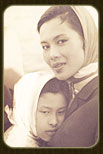
Photograph 2
Mother of the Nation
Her Majesty the Queen is shown embracing Their Royal Highness Princess Chulabhorn Walailak, holding the young princess close to Her chest. The tender moment, with the little princess nestled against Her Majesty, evokes a profound sense of warmth and happiness. The joy of the child, the happiness of the mother, and the harmony of the family together represent the highest form of bliss. This image fittingly honors Her Majesty, as the people have affectionately bestowed upon Her the title “Mother of the Nation.”
This photograph features a beautiful structural composition and expressive qualities, with lighting that evokes a sense of life. The term “structure” refers to lines that guide the viewer’s eye toward the focal point. In this image, the line begins at the face of Her Majesty Queen Sirikit, the Queen Mother, and curves to the right toward the young princess’s face. Here, the line spirals like a small whirlpool, with the princess’s face as the focal point. The composition is particularly remarkable because the visual flow can begin from either the top or bottom of the frame.
The expressive quality is equally striking: the young princess’s eyes convey warmth and happiness, reflecting the joy of a child embraced by a loving mother. His Majesty King Bhumibol Adulyadej captured this portrait both to document a personal royal moment and to offer a model of familial happiness, conveying that when the people are happy, the nation thrives.
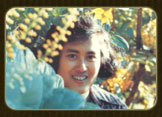
Photograph 3
Forest Turmeric Goddess
By nature, Her Royal Highness Princess Maha Chakri Sirindhorn has always shown great interest in plants, including ornamental flowers and medicinal herbs. In 1982, while residing at Phuping Palace, the royal gardens received a special plant called forest turmeric. This is a tall tree, with large leaves and thorns along the trunk and branches. Its flowering season occurs in early summer, around February, producing long yellow flower spikes resembling golden turmeric, and it blooms only once a year.
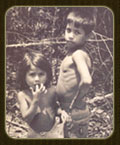
Photograph 4
The Gaze
During a royal stay at Klai Kangwon Palace, Hua Hin, Prachuap Khiri Khan Province, one afternoon His Majesty drove the royal car Himself to observe firsthand the everyday lives of the local people in the surrounding area.
Along the way through rural roads at the edge of the forest, His Majesty noticed two local children. Both were shirtless; the boy stood with his hands on his hips, staring intently, while the girl held a snack, her finger at her mouth, gazing curiously. Pleased and intrigued, His Majesty immediately captured the moment with His camera.
This photograph is an example of a human-interest image, truly capturing life. Each time one looks at it, the children’s gaze and the girl’s finger at her mouth seem to remain frozen in time, as if she has not resumed eating. Beyond its artistic excellence, viewers are deeply moved by His Majesty’s compassion and attention to the well-being of His subjects, extending even to rural children.
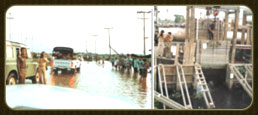
Photograph 5 (Untitled)
In 1983, a major flood occurred, causing widespread damage to the population, particularly in Bangkok and surrounding provinces, where people lived in densely populated areas. Numerous government and private agencies were also affected.
His Majesty King Bhumibol Adulyadej was deeply aware of the hardship caused by this flood and personally visited the severely affected areas. He photographed every aspect with His personal camera. After compiling the images, He summoned senior officials from agencies involved in flood management to report the situation. Studying the environmental conditions, He provided royal guidance for flood mitigation, which government agencies promptly implemented to alleviate the suffering of the people.
His Majesty’s photographs have been widely published on book covers, within books, and in numerous journals. His photographic expertise also gained international recognition. The Royal Photographic Society of the United Kingdom invited Him to become an Honorary Fellow, and the International Federation of Photographic Art (FIAP) conferred upon Him the highest distinction, the Honorary Excellent FIAP. His Majesty’s skill and contributions are documented in the memorial reports of Mr. Jit Jongmankong, as well as in correspondence from Mr. Kenneth R. Warr, Secretary of the Royal Photographic Society, addressed to the Royal Secretary, and letters from FIAP to the Photographic Society of Thailand under Royal Patronage.
พระมหาการุณ พระคุณเลิศ
ทวยราษฎร์เทิดอัจฉริยะ พระมิ่งขวัญ
พระหมายมุ่งผดุงสุข ทุกชีวัน
ทรงถ่ายภาพเพื่อสร้างสรรค์ และพัฒนา
(Kunying Kulsap Kasemnaenkij, Author)
2.3 Musical Arts (Music)
His Majesty the King was a composer highly admired by musicians both in Thailand and around the world. He showed an interest in music from an early age. While studying in Switzerland, He received music lessons from Mr. Weybrecht, an Alsatian teacher, who instructed Him in reading musical notation and performing classical music at Villa Wartenberg. Each lesson lasted 30 minutes. His Majesty purchased musical instruments using pocket money granted by Her Royal Highness Princess Srinagarindra, and with Princess Srinagarindra contributing half the cost and His Majesty paying the other half, He was able to acquire the instruments.
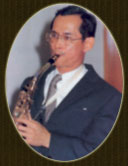
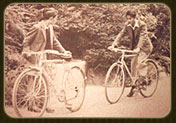
As He grew older, He would ride a bicycle to His teacher’s home for music lessons. Among the instruments, He favored wind instruments the most, and thus became highly skilled in playing several types, including the tenor saxophone, baritone saxophone, clarinet, and trumpet.
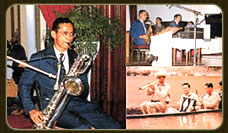
After ascending the throne, His Majesty acquired a piano to aid in composing music and to play privately with ensembles for His personal enjoyment.
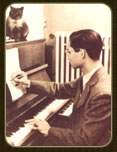
He played the piano.
His Majesty King Bhumibol Adulyadej was widely acclaimed for his exceptional skill on the soprano saxophone, considered the finest in Thailand. His favorite music was Dixieland Jazz, an American style originating in New Orleans after 1916. This lively and spirited jazz allows performers to freely express their emotions and feelings through melodic improvisation. It also requires only a few instruments to form a band, making it ideal for amateur musicians to gather and play among close friends.
His Majesty King Bhumibol Adulyadej held music in the highest regard, considering it the most important of all arts.
“… Music is one of the most significant arts, or perhaps the most important art of all. At least in the heart of a musician, it must be so, because music is an art that brings the greatest joy, pride, delight, and satisfaction. Other arts, when practiced or mastered, do not provide the same level of fulfillment as music. Music, whether performed by a musician, composed in melody or lyrics, or in any role related to music, brings profound pleasure and satisfaction …” (Kasetsart University, 1987: 24)
“… Music has immense power and requires little expense. Just a few written notes and playing them can give people a sense of joy and feeling, sometimes even goosebumps. Ultimately, if practiced continuously, it can influence the mind and even change one’s heart.”
Thus, music benefits ordinary people who neither play instruments, compose, nor sing. Simply listening to music can move the mind, bringing joy, alleviating sorrow, or creating excitement. It can guide emotions in various ways. This is the significance of music, which surpasses other arts …” (Kasetsart University, 1987: 26-27)
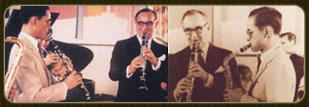
He performed music together with Benny Goodman.
His Majesty King Rama IX used music as a medium to bestow royal benevolence upon students and university pupils. He employed it to strengthen friendships and connections exceptionally well when visiting foreign countries, as music is a universal language that can overcome barriers of language, age, customs, and cultural differences. Musical expression can convey meaning to everyone and foster mutual understanding, a method that has proven successful many times. Benny Goodman, the famous King of Swing and world-class clarinetist, personally witnessed His Majesty’s skill when he “conversed” with him using the clarinet in an informal setting at Amphorn Sathan Throne Hall, Dusit Palace. Similarly, His Majesty performed musical dialogues with renowned tenor saxophonist Stan Getz, trombonist Jack Teagarden, and world-class vibraphonist Lionel Hampton.
During both official and private visits abroad, His Majesty King Rama IX used musical dialogue with world-renowned musicians in various countries, impressing hosts everywhere. For example, during his visit to the United States in 1960 (B.E. 2503), he attended a state dinner at Washington Place, Honolulu, hosted by the Governor of Hawaii. After the meal, the host arranged a swing band performance by “Kenny Alford and his Dixiecats.” Learning of His Majesty’s exceptional musical skill, the hosts invited him to perform with the band. Princess Vibhavadi Rangsit recorded in her book Royal Visit to the United States, B.E. 2503 that His Majesty joined them on clarinet for two pieces, Blues in B Flat and Back Home in Indiana, to great applause. His casual, approachable manner delighted the American audience.
Later, in New York City, Governor Nelson A. Rockefeller hosted another state dinner. Benny Goodman, the “King of Jazz,” performed with his ensemble. Again, the guests encouraged His Majesty to join in. He graciously accepted and played alongside the famed jazz musician.
On the following day, 5 July 1960, His Majesty visited Benny Goodman at his home at 200 East 66th Street, New York. When American journalists asked if he was truly a jazz musician and which style he preferred, His Majesty replied:
“Music is a part of me, whether jazz or not. Music exists within everyone and is a vital part of our lives. For me, music is a refined art, and everyone should appreciate the value of all types of music, as each style is suitable for different occasions and moods.”
When speaking about performing music, His Majesty distinguished between styles. He explained that playing classical music requires full concentration and any external noise would be disturbing, as one must be careful not to miss a note. In contrast, when playing jazz, he could improvise freely according to his mood and feelings. Any surrounding sounds were considered part of the accompaniment, and even if he played a “wrong” note, it was effectively composing a new melody in the moment.
In 1963 (B.E. 2506), during his state visit to the Philippines, after completing his official duties, His Majesty performed music with members of the Philippine Senate at the Thai Embassy in Manila. His skill left a deep impression on the Filipino people and strengthened bilateral relations.
Later, in 1966 (B.E. 2509), King Rama IX and Queen Sirikit visited the Federal Republic of Germany on an informal visit. The Bremer Nachrichten newspaper, dated 26 August 1966, reported:
“At the farewell dinner, the Harold-Eckstein-Sextett performed His Majesty’s compositions. The King joined in, playing saxophone and clarinet, accompanied on piano by Bodo Selge, Mayor of Bremerhaven.”
According to A.S.P.N., His Majesty demonstrated extraordinary ability in ad-libbing (solo ad-lib). Musicians are usually trained to follow notes strictly, but His Majesty could perform both with and without sheet music. Even during solo improvisations, he maintained the structure and flow of the piece perfectly, never losing the melody or going off track. This mastery of solo ad-lib, highly challenging even for professional musicians, reflected His Majesty’s exceptional musical genius.
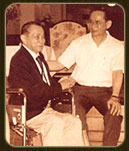
King Rama IX was highly knowledgeable in the theory of both classical and jazz music, and he excelled equally in performing both genres. In addition, he possessed profound knowledge of music history. He once explained to Mom Chao Chakrapan Pensiri Chakrapan (then holding that title) that the blues of African Americans, though often expressing suffering, ultimately conclude with a life philosophy of perseverance. Beyond his exceptional skill in imparting knowledge, His Majesty was also a music teacher. When he established the “Sahai Phatthana Brass Band” (วงแตรวงสหายพัฒนา), Mom Chao Chakrapan Pensiri provided an interview regarding the brass band as follows.
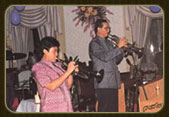
“… He established the Sahai Phatthana Brass Band, bringing together those who served closely with Him and regularly accompanied His Majesty on rural development trips in various regions, such as medical teams, royal guards, security personnel, agricultural officers in the royal household, and other attendants. Most of these individuals had never played music before. However, with the little time His Majesty granted for training, combined with His special teaching methods, He successfully formed the brass band named ‘Sahai Phatthana’.”
He could perform music skillfully, greatly benefiting His Majesty’s rural development work. This new brass band also had the potential to progress much further, thanks to the exceptional musical genius of King Rama IX, who employed his extraordinary abilities as a teacher. His guidance became an inspiration and encouragement for everyone in the music field, motivating them to follow in His footsteps for the highest benefit of the Thai nation (Office of the Higher Education Commission, 1996: 551, citing A.S.P.N., 1986, The Musical Genius of King Rama IX in Thai Culture, 25 February 1986: 13–20).
Besides being a musician, King Rama IX was also a composer. On some occasions, He composed both the melody and the lyrics, such as in Dream Island, Echo, No Moon, Still on My Mind, and Old–fashioned Melody. From 1946 to the present, He has composed a total of 48 pieces, mostly providing the melody while graciously granting permission for Prince Chakrapan Pensiri, Mr. Manrat Srikranon, or Mom Luang Senee Pramoj to compose the lyrics. Typically, King Rama IX would create the melody first and then allow close associates to write the lyrics. There are four pieces where He composed the melody to match the lyrics: Supreme Dream, We Fight, Love, and Egg Menu (SILPA WATTANAKAN, 17(3), January 1986: 29). Most songs have lyrics in Thai and English, some are only in Thai, such as New Year’s Blessing, Kasetsart, Chamchuri, Supreme Dream, We Fight, while a few are in English only, such as Oh I Say. Some pieces consist solely of melodies without lyrics, such as Ray Kram Goes Dixie, The Nuture Walze, The Hunter, Kinari Walze, and The Great Auspice (the anthem of the Suntharaporn Band).
Examples of Royal Compositions:
1. Candlelight Blues: This was the first song composed in April 1946, when His Majesty held the title of Somdej Phra Anuchathirat. He graciously allowed Prince Chakrapan Pensiri to write Thai lyrics. However, as the King intended to revise parts of the melody and chords, it was not performed immediately. Later, it was first performed in 1947, and in 1953 Ms. Sodsai Vanichwattana (Associate Professor Sodsai Phanthumkomol) wrote the lyrics.
จุดเทียนบวงสรวงปวงเทพเจ้า
สวดมนต์ค่ำเช้าถึงคราวระทมทน
โอ้ชีวิตหนอล้วนรอความตายทุกคน
หลีกไปไม่พ้นทุกข์ทนอาทรร้อนใจ
ต่างคนเกิดแล้วตายไป
ชดใช้เวรกรรมจากจร
นิจจังสังขารนั้นไม่เที่ยงเสี่ยงบุญกรรม
ทุกคนเคยทำกรรมไว้ก่อน
เชิญปวงเทวดาข้าไหว้วอน
ขอพรคุ้มไปชีวิตหน้า
ทนทรมานมามากแล้วจะกราบลา
หนีปวงโรคาที่เบียดเบียน
แสงแววชีวาเปรียบแสงเทียน
เปรียบเทียนสิ้นแสงยามแรงลมเป่า
ชีพดับอับเฉาเหมือนเงาไร้ดวงเทียน
จุดเทียนถวายหมายบนบูชาร้องเรียน
โรคภัยเบียดเบียนแสงเทียนทาน
ลมพัดโบย
โรครุมเร่าร้อนแรงโรย
หวนโหยอาวรณ์อ่อนใจ
ทำบุญทำทานกันไว้เถิดเกิดเป็นคน
ไว้เตรียมผจญชีวิตใหม่
เคยทำบุญทำคุณปางก่อนใด
ขอบุญคุ้มไปชีวิตหน้า
ทนทรมานมามากแล้วจะกราบลา
แสงเทียนบูชาจะดับพลัน
แสงเทียนบูชาดับลับไป
CANDLELIGHT BLUES
The candlelight is shining low,
My only love, I’m missing you so
I know I’ve lost but still I dream of you
I’ll hope and dream till all my dreams come true.
Just by the candlelight
You used to hold me tight
This candlelight reminds me so of you
By candlelight you kissed me
Still the candle’s burning for two
But darling, where can you be?
Come back, my love, if you’re feeling this blue
By candlelight you’ll meet me
But darling where can you be?
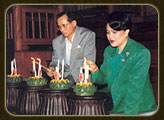
2. Royal Composition: Love at Sundown
The second royal composition was written in 1946 while His Majesty was still Somdej Phra Anuchathirat. He graciously allowed Prince Chakrapan Pensiri to write the Thai lyrics, and Thanphuying Nopakun Thongyai Na Ayudhya composed the English lyrics. The completed song was then granted to Mr. Ua Sunthornsanan to perform at the Tuberculosis Association event on the Amphon Garden dance floor on Saturday, 4 May 1946. This marked the first royal composition to be performed publicly. The piece was cheerful and lively, suitable for dancing at the time, and quickly became popular among the Thai people.
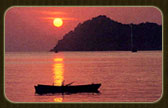
ยามเย็น
แดดรอนรอน
ทอแสงเรืองอร่ามช่างงามตา
แดดรอนรอน
ยามนี้จำต้องพรากจากดวงใจ
แต่ก่อนเคยคลอเคลียกัน
ต้องอยู่เดียวเปลี่ยววิญญาณ์
แดดรอนรอน
ความรักเรายังอยู่คู่กันไป
แดดรอนรอน
คลอเคล้าพฤกษาชาติชื่นเชยชม
ลิ่วลมโชย
ยามสายัณห์พลันพรากจากดวงใจ
แต่ก่อนเคยคลอเคลียกัน
ต้องอยู่เดียวเปลี่ยววิญญาณ์
โอ้ยามเย็น
ยามไร้ความสว่างห่างทินกร
เมื่อทินกรจะลับเหลี่ยมเมฆา
ในนภาสลับจับอัมพร
เมื่อทินกรจะลาโลกไปไกล
ไกลแสนไกลสุดห่วงยอดดวงตา
ทุกวันคืนรื่นอุรา
เหมือนดังนภาไร้ทินกร
หากทินกรจะลาโลกไปไกล
ในหัวใจยังอยู่คู่เชยชม
หมู่มวลภมรบินลอยล่องตามลม
ชมสมตามอารมณ์ล่องเลยไป
กลิ่นพรรณไม้โปรยโรยร่วงห่วงอาลัย
คอยแสงทองวันใหม่กลับคืนมา
ทุกวันคืนชื่นอุรา
เหมือนดังนภาไร้ทินกร
จวบยามนี้เป็นเวลาสุดอาวรณ์
ยามรักจำจะจรจากกันไป
LOVE AT SUNDOWN
‘Tis sundown.
The golden sunlight tints the blue sea.
Paints the hill and gilds the plam tree,
Happy be, my love, at sundown.
‘Tis sundown.
The multi-coloured dancing sunbeam
Brightly shines on in my heart’s dream
Of the one I love, at sundown.
The birds come to their nest
At peace, they bill and coo.
The wide world sinks to rest,
And so do I and so do you.
‘Tis sundown.
In splendour sinks the sun, comes twilight,
Day is done, now greets the cool night.
Happy be, my love, at sundown.
The royal composition “Rainfall” is one month younger than the royal composition “Love at Sundown,” yet it has enjoyed enduring popularity among Thai citizens across all regions of the country. His Majesty King Rama IX recounted that after returning to reside permanently in Thailand in 1951, the first long-term royal duty he undertook was visiting people in various provinces across the northeast, north, south, and other regions. He remarked, “covered in dust all day.” In the evening, he would host government officials, merchants, and citizens, providing royal dinner at the provincial hall or his temporary residence. His Majesty would observe local performances, and one performance that was indispensable was the Rain Dance, which was performed each time in various styles. He noted, “…there are the light pitter-patter rains and the gentle drizzle rains,” as the people considered it a symbolic song, and he took great pleasure in it as a composer.
For the nation and the Thai people, it was a tremendous honor and source of pride when the royal composition “Rainfall” was unanimously selected by members of the United Nations Educational, Scientific and Cultural Organization (UNESCO) from 18 countries at a meeting held in Tokyo in 1980 to serve as the official song of the Asian countries group, with the English title “Song of Asia” (Khun Ying Kanita Lekhakul, 1996: 209).
3. Royal Composition: Rainfall
The third royal composition, “Rainfall,” was composed in 1946 when His Majesty was still the Prince and Duke. He graciously commissioned Prince Chakkaphan Pensiri to write the Thai lyrics, while the English lyrics were co-written by Prince Chakkaphan Pensiri and Thanpuying Noppakun Thongyai Na Ayudhya. This royal composition features a gentle and tender melody and was first performed at the celebration of the Thai Poultry Promotion Association on the dance stage at Suan Amporn on Sunday, 2 June 1946. Since then, it has remained one of the most beloved songs among the Thai people.
สายฝน
เหมือนจะเอนรากคลอนถอนไป
พระพรหมท่านบันดาลให้ฝนหลั่ง
น้ำทิพย์สาดเป็นสายพรายพลิ้วทิวงาม
สาดเป็นสายพรายพลิ้วทิวทุ่ง
รุ้งเลื่อมลายพร่างพรายนภา
พระพรหมช่วยอำนวยให้ชื่นฉ่ำ
น้ำฝนหลั่งลงมาจากฟ้าแดนไกล
ต้นไม้พลิ้วลู่กิ่งใบ
แต่เหล่าไม้ยิ่งกลับงาม
เพื่อประทังชีวิตมิทราม
ทั่วเขตคามชุ่มธารา
แดดทอรุ้งอร่ามตา
ยามเมื่อฝนมาแต่ไกล
เพื่อจะนำดับความร้อนใจ
พืชพรรณไม้ชื่นยืนยง
FALLING RAIN
Rain winds sweep across the plain.
Thunder rumbles on high.
Lightning flashes ; bows the grain.
Birds in fright nestward fly.
But the rain pours down in blessing.
Filled with cheer our hearts expand.
As the woods with notes of pleasure ring,
Sunlight streams o’er the land.
Bright the rainbow comes in view.
All the world’s cool and clean.
Angels’ tears the flowers renew.
Nature glistens in green.
Rain beads sparkle in your hair, love.
Rainbows glitter when you smile.
Thus we soon forget the clouds above,
Beauty so does beguile.

4. Royal Composition: Love
The 47th royal composition, “Love,” was composed in December 1994. Her Majesty Queen Sirikit, the Queen Mother, respectfully requested His Majesty King Rama IX to compose a melody for three stanzas of refined verse written by Her Royal Highness Princess Maha Chakri Sirindhorn when she was 12 years old. His Majesty graciously provided this composition to the Royal Music Ensemble, which performed it every Friday and Sunday throughout December 1994.
Later, after making revisions, His Majesty graciously commanded Mr. Manrat Srikranon to arrange and harmonize the composition so that it could be performed together with the Royal Music Ensemble on Fridays during the Royal Year-End and New Year Banquet in 1995 at the Borom Phiman Throne Hall in the Grand Palace. His Majesty kindly instructed that the lyrics of the royal composition “Love” be distributed in advance to all invited guests at each table. Guests, including members of the Privy Council, Cabinet members, Prime Minister Chuan Leekpai, and senior military and police officers, were then invited to sing the composition on stage, table by table, while His Majesty personally led the musical performance. Subsequently, His Majesty also graciously permitted the composition to be broadcast on Radio Station J.S. 100 in early 1995.
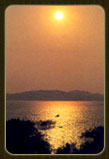
รักทะเล
รักท้องฟ้า
รักท้องทุ่ง
รักป่าเขา
รักพฤกษา
รักปักษา
รักอุทัย
รักทั้งรัต –
รักดารา
รักน้ำค้าง
รักทั้งหมด
รักนวลนาง
รัก
อันกว้าง
โอฬาร
ท้องนา
ลำเนาไพร
รุกขชาติ
ร้องกู่
สว่าง
ติกร
ส่องแสง
อย่างมณี
รักทั้งสิ้น
รักจน
ใหญ่ไพศาล
สีสดใส
ดังดวงใจ
แสนสุนทร
ที่ดาษป่า
บนสิงขร
กลางอัมพร
ในนภดล
สุกสว่าง
มีโภคผล
ที่ได้ยล
หมดสิ้นใจ
5. Royal Composition: Egg Menu
The 48th royal composition, “Egg Menu,” was composed on 6 May 1995 as a birthday gift for Her Royal Highness Princess Galyani Vadhana, the Princess of Naradhiwas, on the occasion of her 72nd birthday. His Majesty was inspired to compose it upon recalling that the Princess favored egg dishes, and he combined this inspiration with a quatrain titled “Egg Menu” written by Her Royal Highness Princess Maha Chakri Sirindhorn in 1975. His Majesty graciously entrusted Rear Admiral Mom Luang Atsani Pramoj to arrange and harmonize the composition so that the Royal Music Ensemble could perform and sing it on Friday during the royal banquet celebrating Her Royal Highness Princess Galyani Vadhana at Dusit Thani Hall on 8 May 1995.
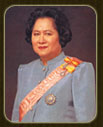
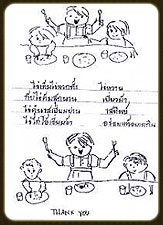
เมนูไข่
เมนูไข่เมนูไข่
เมนูไข่เมนูไข่
ไข่เค็มไข่ลวกทั้ง
กับไข่ต้มสุกนาน
เมนูไข่เมนูไข่
ไข่ตุ๋นรสเยี่ยมปาน
ไข่ไก่โอ้เอี่ยมอ้า
เมนูไข่เมนูไข่
เมนูไข่เมนูไข่
เมนูไข่เมนูไข่
เมนูไข่เมนูไข่
เมนูไข่เมนูไข่
อร่อยแท้อยากกิน
อร่อยแท้อยากกิน
ไข่หวาน
เยี่ยวม้า
อร่อยแท้อยากกิน
รสทิพย์
อร่อยแท้อยากกิน
อร่อยแท้อยากกิน
อร่อยแท้อยากกิน
อร่อยแท้อยากกิน
อร่อยแท้อยากกิน
อร่อยแท้อยากกิน
In terms of music for the public, His Majesty graciously commanded the Royal Music Station to hold regular public performances at the dance stage of Suan Amporn on Wednesday afternoons and Sunday mornings, before television became available in Thailand. The military bands of the army, navy, and air force, the police band, the Public Relations Department band, university ensembles, and private orchestras took turns performing music of all kinds, including Western music, bringing great joy and delight to the people at that time.
Royal compositions with melodious tunes that are easy to sing and remember include the composition “New Year’s Blessing,” which has become a traditional song for New Year celebrations in Thailand. The compositions “Maha Chulalongkorn,” “Yuang Thong” (Thammasat University), and “Kasetsart” have become sacred songs of these three prestigious universities. In military ceremonial music, “March Rajawallop” and “March Thong Chai Chalermphon” have become standard march pieces performed annually during the most important military ceremonies, such as the oath-taking of the Royal Guard units and the inspection of troops at Dusit Palace on the occasion of His Majesty’s birthday each year.
As the national situation changed and Thailand faced uncertain circumstances, His Majesty King Rama IX delivered royal guidance to musicians, composers, and performers, emphasizing the importance of music for national security.
His Majesty also composed inspirational music to encourage government officials, military personnel, civilians, and the public in their service to the nation, reminding them to remain steadfast and not lose heart in performing good deeds for the nation, religion, monarchy, themselves, and society. Examples include the royal compositions “The Highest Dream” and “We Shall Fight.”
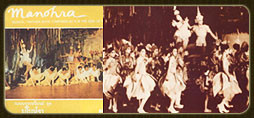
The ballet “Manora”
One of the highest abilities that marks a composer as a musical genius is the capacity to create long compositions that remain melodious and engaging. In addition to His Majesty King Rama IX’s exceptional skill in composing individual songs, both melody and lyrics, he also composed musical suites. A suite is an extended composition consisting of multiple sections, each requiring a different style, demanding advanced compositional ability. His Majesty composed suites including “Manora” (Kinari Suite) and graciously entrusted the Suntharaporn Orchestra to perform it in accompaniment to the “Manora” ballet at the dance stage of Suan Amporn, raising funds for the Thai Red Cross Society. This was a major charitable event at the time, and His Majesty personally oversaw the rehearsals, demonstrating his remarkable talent in theatrical arts.
Prince Chakkaphan Pensiri remarked on the suites composed by His Majesty:
“The suites he composed were intended for various theatrical productions, such as ‘Saeng Duean’ and the ‘Manora Suite’ or Kinari Suite. In the Manora Suite, His Majesty personally arranged and harmonized the composition. The music is both captivating and expressive, reflecting the content of the piece and leaving a strong impression on the audience. These royal compositions have also been performed by leading orchestras from several countries, including the N.Q. Tonkunstler Orchester of Austria and NHK Orchestra of Japan.”
His Majesty’s musical genius has been admired internationally. For instance, during the official state visit of His Majesty King Rama IX and Her Majesty Queen Sirikit to the Republic of Austria on 3 October 1964, the N.O. Tonkunstler Orchester, conducted by Heinz Wallberg, performed the royal compositions “Manora,” “Rainfall,” “Love at Sundown,” “March Royal Thai Navy,” and “March Rajawallop” at the Concert Hall in Vienna. At the same time, Austria’s national radio broadcast these royal compositions nationwide. This marked the first occasion that an Asian monarch played such a prominent role in the world’s music capital.
His Majesty King Rama IX possessed the soul of an artist, a deep love for music, and a profound musical genius. He was a music teacher, fluent in the language of music. In recognition of his achievements and with great pride, the National Culture Commission collectively bestowed upon His Majesty the honorary title “Supreme Artist,” noting:
“… His royal musical endeavors were not undertaken solely for himself or those close to him, but also extended to his subjects, aiming to promote, preserve, and make widely known the nation’s musical arts, ensuring that they remain an enduring part of Thai culture…” (Uab Hemaratchata, 1987: 1)
2.4 Literature
His Majesty King Rama IX composed original works and also produced translations, including:
- The original work “When I Left Siam for Switzerland” in 1946.
- The translated work “Nai In, the Man Who Worked Behind the Scenes” between 1977 and 1980, over a period of three years.
The translated work “Tito”, which he began translating in 1976 and was first published in 1994.
In addition, there are 11 other translated works, including:
- “Nightmares Need Not Come True”, translated and adapted from “No Need for Apocalypse” in The Economist, 17 May 1975.
- “Buddhist Economics: Chapter 4, Small is Beautiful”, translated and adapted from Small is Beautiful by E.F. Schumacher.
- “From Radio for Peace and Progress News”, translated and adapted from “Radio Peace and Progress” in Intelligence Digest, 1 April 1975.
- “The Marxist Advance”, translated and adapted from The Marxist Advance of Special Brief.
- “Report on the Communist Line”, translated and adapted from Following the Communist Line.
- “London Report”, translated and adapted from London Report in Intelligence Digest, 18 June 1975.
- “Eternal China”, translated and adapted from Eternal China in Intelligence Digest: Weekly Review, 13 August 1975.
- “Surprising Views from a Post-Allende Chile”, translated and adapted from Surprising Views from a Post–Allende Chile in Intelligence Digest: Weekly Review, 20 August 1975.
- “Sauce for the Gander”, translated and adapted from Sauce for the Gander in Intelligence Digest: Weekly Review, 20 August 1975.
- “Red China: Drug Pusher to the World”, translated and adapted from Red China: Drug Pusher to the World in Intelligence Digest: Weekly Review, 20 August 1975.
- “Fashion in Heroes”, translated and adapted from Fashion in Heroes by George F. Will in Newsweek, 6 August 1979.
The royal composition “Phra Mahachanok” was translated from the Tripitaka, completed in 1988, and first published in 1996.
The royal composition “Thongdaeng” was composed in 2002.
All of His Majesty’s works are noted for their concise, elegant language and vivid expression.
2.4.1 The royal composition “When I Left Siam for Switzerland” is a diary-style work by His Majesty King Bhumibol Adulyadej, written both before and during his flight to study in Switzerland in 1946, when he was 19 years old. It is the first royal composition of His Majesty and was not widely published, appearing only in the appendix, pages 195–203, of The King and the People: 48 Years of the Royal Radio Station, Dusit Palace, published in 1999 by the Royal Radio Station, Dusit Palace, and the Government Savings Bank to honor His Majesty’s sixth cycle birthday. It was also published in the book Romklao for National Children’s Day 1988, pages 14–27, by the Ministry of Education.
This royal composition provides detailed accounts of His Majesty’s conduct from 16 August 1946 to 22 August of the same year. Khun Khwan Kaew Watcharothai delivered a special lecture on 2 June 1995, which was recorded in the previously cited book The King and the People: 45 Years of the Royal Radio Station, Dusit Palace (1999: 857–858), stating:
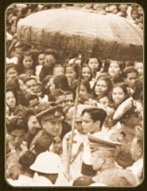
I would like to recount the journey from Thailand to Switzerland in 1946 (B.E. 2489).
In 1946, the journey by airplane from Bangkok to Switzerland took three nights and two days: the first night stopping in Ceylon, the second in Karachi, and the third in Cairo, arriving in Geneva, Switzerland, on the fourth day. What has not changed despite technological advancements—whether in aircraft speed, news transmission, or global competition—was His Majesty King Bhumibol Adulyadej’s concern for the nation and the Thai people. He was determined to develop both his people and the country, as they had loudly expressed during his return to Switzerland to continue his studies after assuming responsibility for governing the country: “Do not abandon the people.” His Majesty answered through the literary journal Wong Wonnakadi: “If the people do not abandon me, how could I abandon them?” The fifty years of his reign have proven that he never abandoned his people.
It can be seen that what Khun Khwan Kaew Watcharothai remarked in 1995 remains true today in 2002: His Majesty King Rama IX continues to care deeply for the nation and the Thai people, with even greater concern, as evidenced by the steadily increasing number of royal initiative projects, which now number nearly 2,500.
Analyzing this royal composition, it is evident that His Majesty King Rama IX demonstrated literary genius as early as age 19.
1) He used concise and straightforward written language, showing decisiveness and avoiding unnecessary elaboration, for example: “Packing the trunk and preparing…” (p. 14, 17 August 1946).
2) Wordplay
2.1 He employed rhyming and alliteration, a distinctive feature of Thai literary style, as seen in lines such as “yad yued bried siet, chaiyo ho rong, auai chai hai phon, dunsan wan wai, ho rong kong kang wan, chang lamai klang khlueng, kwang yai phai san, chao kork ngok ngoei, bried siet yia yud, thi mai plai thang, mai chi wit jit jai” (showing parallel consonant and vowel sounds).
2.2 He used paired word repetition for emphasis, e.g., “pai nai ma nai” (repeating nai), “wab wab wam wam” (repeating wam), “thap khaeng thap kha” (repeating thap), “liang ped liang kai” (repeating liang), “kan thang… rot laen dai saduak, kan khon… (rot laen) cha koen pai, mi khwam suk khwam charoen” (repeating kan and khwam).
2.3 He skillfully used repeated consonant sounds in consecutive words, such as:
- “thua thanon thuk sai” (using th and than)
- “dern fa fung khon seung fa doo” (using f)
- “thit tawan tok mung trong” (using t)
- “saduak sabai dee” (using s)
- “non lap yang sabai yuu khang thang” (using y)
- “mi tamruat iyipt yuen yam yuu” (using y)
- “yang saen sabai tam sanam ya” (using s)
- “dai chi chuan hai chom” (using ch).
- 3) Techniques for Emphasizing Words to Create Clear Imagery His Majesty used repetition with synonymous expressions to make the text more vivid and engaging. For example:
- “เป็นประจำมิได้ขาด” (“regularly without fail”) emphasizes “เป็นประจำ” (“regularly”), which conveys the same meaning as “มิได้ขาด” (“without fail”).
- “ปุปะไม่มีชิ้นดี” emphasizes “ปุปะ” (“messed up”), with a meaning similar to “ไม่มีชิ้นดี” (“utterly ruined”).
- “เพื่อจะรีบไม่ให้ชักช้า” emphasizes “เพื่อจะรีบ” (“in order to hurry”), similar to “ไม่ให้ชักช้า” (“without delay”).
- “เจริญงอกงาม” emphasizes “เจริญ” (“flourishing”), similar to “งอกงาม” (“growing well”).
- “ท้องฟ้าแจ่มกระจ่าง” emphasizes “แจ่ม” (“bright”), similar to “กระจ่าง” (“clear”).
- “ระคนปน” emphasizes “ระคน” (“mixed”), similar to “ปน” (“blended”).
- “สุขสำราญ” emphasizes “สุข” (“happy”), similar to “สำราญ” (“joyful”).
- “ห้อยโหน” emphasizes “ห้อย” (“hanging”), similar to “โหน” (“swinging”).
- 4) Sentence Construction His Majesty’s sentence structure adhered strictly to Thai grammatical rules and achieved completeness and clarity.
a. Appropriate use of connectors
- The sound of the airplane was deafening; if anyone spoke, they would have to shout at the top of their voice.
- Therefore, no one spoke… wishing to sleep early for a bit.
- However, one had to eat with the officials and the entourage and engage in conversation.
- The best course of action was to close one’s eyes and quietly reflect…
- The people were polite and well-mannered.
- By the time one could rest and sleep, nearly two watches had passed.
b. Complete sentences with cause and effect
His Majesty often wrote sentences that fully linked cause and effect. When mentioning a “cause,” he would describe the “effect,” and sometimes he would state the “effect” first, then explain the “cause.” This approach demonstrates his mastery of logical and coherent writing.
- “The reason it looks so similar is primarily because they share the same religion as us.”
- “It is not as hot here as in Thailand, and there are no mosquitoes; therefore, mosquito nets are not necessary.”
- “The grayish color observed, rather than pure white, is due to a mixture with dust.”
- “The Westerners call them ‘bumps’—high air currents caused by the heat of the sand below, heated by the blazing sun.”
- “We were exhausted because we were disturbed by the deafening noise of airplanes, air turbulence, and engine vibrations, which made us completely disoriented…”
- “Outside our room, Egyptian policemen were standing guard, as arranged by the Egyptian government for our safety.”
- “…I have come to know these places very well, having been here for over 14 years.”
c. Linking multiple sentences or events sequentially, His Majesty skillfully used words to indicate different stages clearly, for example:
“…Upon arrival… only a few people were waiting.
…Now, more people have gathered.
…When leaving … and arriving at …, such a large number of people…”
(This method gradually illustrates the increasing crowd, allowing readers to follow the narration closely and visualize the scene vividly and engagingly.)
5) His Majesty beautifully compared two things, both linguistically and imaginatively, for example: “When compared to the vast expanse of the sea and the immense emptiness of the desert.”
6) He employed descriptive rhetoric, using elegant language to evoke vivid imagery and emotions in the reader, for example:
“We were flying over the vast and boundless sea; even though the engines made noise, it seemed as if everything were silent and still, for every sound from living beings had completely faded away.”
“The journey in the following stretch was truly desolate. Nothing could be seen ahead except the deep turquoise sea, with islands appearing only occasionally.”
“The citizens wore tattered clothing, originally white, though now appearing more gray due to dust mixed in.”
“…The size of this ship seemed about fifteen times that of the Sri Ayudhya ship. Even so, it appeared remarkably small when compared to the vast expanse of the sea and the immense emptiness of the desert.”
“…Along the tram-lined streets, people were packed tightly together, hanging and jostling, all dressed in tattered clothes beyond repair.”
“…From the hazy horizon, veiled by mist and clouds, a town could be seen along the edge of a large lake.”
- 7) His Majesty conveyed his sense of humor exceptionally well, making the narrative engaging and prompting readers to seek answers.
“Some people were seen at the Grand Palace regularly without fail. No one knew where they found the time, yet they always managed to be there almost every Tuesday, Thursday, and Sunday.”
“…One could also see sacred cows wandering the main streets in search of food. Wherever they went, no one dared to drive them away. Whenever they felt hungry and found a vegetable stall, they could freely choose what to eat, and the shop owners considered the cows’ presence a sign of good fortune…”
From the examples of His Majesty’s literary works presented, it is evident that King Bhumibol Adulyadej possessed exceptional mastery of the Thai language, using it with precision and appropriateness. Even at the age of 19, while residing abroad for his studies for over 14 years, He never forgot how to speak or write in Thai. His conduct serves as a model for all Thai people to follow, preserving and upholding the national language for generations to come. His literary genius is truly admirable and worthy of highest respect.
2.4.2 “Nai In, the Man Who Works Behind the Scenes”
This is a royal translation of the book A Man Called Intrepid by Sir William Stevenson. His Majesty began translating the first page on June 20, 1977, dedicating his personal time to translate gradually, day by day, and completed the final page on March 23, 1980, taking a total of three years. Through His Majesty’s diligence and perseverance, the translation maintained a consistent linguistic quality, allowing the Thai people to become acquainted with “Nai In,” or “Intrepid.”
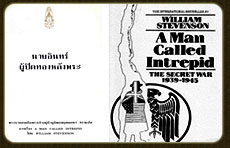
Nai In, the Man Who Works Behind the Scenes recounts the secret war from 1939 to 1945 (B.E. 2482–2488), previously unrevealed. Sir William Stevenson was entrusted to disclose certain confidential matters to honor the sacrifices of those who worked covertly for their countries. The book also serves as a reference in case similar clandestine operations are required in the future. Another purpose was to provide accurate information to the public, preventing adversaries from distorting history, which could have strained relations between the United States, Canada, and the United Kingdom. The work of “Nai In” and his collaborators was of immense value to the world; without them, Hitler (then ruler of Germany) might have won the war, and the world would be very different today (Anchalee Thongem et al., 1996: 561).
The content of the book focuses on events during World War II, providing insights into the conduct of secret operations, sharp political remarks, military practices, and the mindset required for covert warfare. It emphasizes that those engaged in secret operations must possess broad and deep knowledge, think carefully, and apply the principle of knowing both oneself and the opponent. The book also offers historical knowledge, factual events of the war, and an understanding of international relations between the two sides (Rangsit Information, 2(1), June–December 1996: 92).
The summary of the translated work Nai In, the Man Who Works Behind the Scenes describes espionage cooperation between Britain and the United States to counter the expansion of Nazi Germany. Nai In acted as a high-level coordinator. The incidents revealed in the book were carefully verified for accuracy. Some events surpass even fictional spy novels, such as the daring operation to steal Germany’s advanced Enigma cipher machine—Hitler believed its communications were unbreakable, yet Nai In successfully orchestrated its theft without German suspicion, allowing his espionage network to gather critical intelligence.
The book also recounts the brave exploits of Madeleine, a spy under Nai In, who risked her life behind enemy lines, and Cynthia, an English agent who used her charm to extract cipher secrets from enemy diplomats.
Nai In (Sir William Stephenson), later head of intelligence in World War II, had previously served in World War I under the code name Intrepid. Injured by poison gas, he nearly became disabled but returned to active service as a pilot. He documented enemy prison camps from his experience as a prisoner, catching the attention of Admiral Blinker Hall. Subsequently, he was called back from London to assist covert operations, monitored by both Hall in England and Bill Donovan in the U.S., to track Nazi movements. Nai In and his associates continued to observe Hitler’s actions closely throughout the war.
They sought to study the secret ciphers used by the Germans via the Enigma machine so that intercepted communications could be correctly interpreted and timely national countermeasures prepared. Through Nai In’s coordination, Britain and the United States established covert cooperation to ready themselves for the coming war. The United States pursued knowledge of Japanese versions of Enigma while Britain gathered information on the various Enigma systems used by Nazi Germany. Meanwhile, Hitler clandestinely manufactured numerous weapons using steelworks and related factories, actions that did not escape the notice of Nai In and his associates.
When Germany declared war on Britain while the United States had not yet entered the conflict, Nai In and his colleagues maintained constant contact with President Roosevelt and coordinated between the FBI and the BSC of Britain. Their cooperation fostered mutual understanding and enabled unofficial American assistance to Britain. Besides intelligence gathering, the group’s methods sometimes included deliberate disinformation and complex stratagems of deception.
The Japanese attack on Pearl Harbor brought the United States openly into the war, and Hitler’s error in declaring war on the United States allowed America to commit fully to the European theater. Plans to mobilize Europe against Nazism succeeded, particularly in opposing Hitler’s threefold policy of forced assimilation: converting subject peoples into Germans through racial selection, expelling or eliminating undesirables including intellectuals, and settling ethnically German populations in the vacated territories.
In summary, warfare comprises two dimensions: one that depends on science and technical experts, and another of covert operations that relies on intuition and individual agents. Future peace will depend on a balanced control of both aspects. This book reveals many behind-the-scenes operations of Nai In’s daring units, including the rescue of leading scientists from Nazi-occupied territories, efforts to prevent Germany from developing an atomic bomb, and strategic operations planned to oppose Nazi domination of Europe, the Americas, and Africa.
“Intrepid” wrote in the preface of this book that the reason he agreed to allow William Stevenson to reveal these stories was to pay tribute to the many who fought for their country, though few would be mentioned beyond the names recorded in secret documents. Most of those who survived returned to ordinary occupations without receiving any honors or awards. Those mentioned in this book are only a small fraction of a vast army. The stories of “Intrepid” and his associates exemplify exceptional individuals who were courageous and selfless, willing to devote even their lives for justice, fairness, freedom, and peace, which they cherished deeply, all without seeking recognition, fame, or praise. These individuals are true “unsung heroes.” (Chamnarn Rodhetpai, 2002: 142–143)
The literary artistry in the translated royal work “Intrepid: The Unsung Hero” demonstrates that His Majesty King Bhumibol Adulyadej possessed remarkable skill in royal writing, both in prose and verse, evident to the public. In particular, the artistry in the choice of words and rhetorical style in many of His Majesty’s translated works is notable. Specifically, regarding “Intrepid: The Unsung Hero,” M.L. Thavesan Ladawan remarked on the King’s linguistic mastery, saying that merely the choice of the book’s title already reflects His Majesty’s translation genius. He selected Thai words and expressions that were broad in meaning and engaging to readers, rather than translating the title literally. Reading the entire work reveals His Majesty’s wisdom in both Thai and foreign languages, as well as his methods of conveying content from one language to another. This work, though a long documentary with complex and academic content, is rendered light and engaging through His Majesty’s use of Thai expressions, occasionally infused with subtle humor.
The research committee of Dhurakij Pundit University similarly noted His Majesty King Bhumibol Adulyadej’s exceptional linguistic skill, stating that the value of language and literary art in the royal translation “Intrepid: The Unsung Hero” is immense, from the choice of the title, translation techniques, methods of conveying content and ideas, to the careful selection of words. All are exquisitely precise and meticulous, blending various styles, all of which are evident throughout the royal work. (Chamnarn Rodhetpai, 2002: 144)
And from the assignment given by Dhurakij Pundit University to Professor Anchalee Thong-em and her team to analyze, compile, and publish in the book The Brilliant King by the Office of the University Bureau, issued on the auspicious occasion of the 50th Anniversary of His Majesty’s Reign (1996: 561–582), the findings can be summarized as follows.
The research team noted that this royal translation employed two main translation techniques:
- Literal translation.
- Translation conveying meaning and content by understanding the original text and adapting it into a Thai style.
His Majesty King Bhumibol Adulyadej translated from English into Thai with a profound and unique approach, evident from the translation of the title, his method of conveying content, and his preference for translating the sense rather than word-for-word. He chose words that readers could easily understand, which evoked vivid imagery, emotions, and feelings. In particular, his wordplay and subtle inclusion of Thai cultural nuances created a seamless cultural integration. More distinctively than ordinary translations, His Majesty added information not present in the original text, making some sections clearer, and in certain parts, he also infused his gentle humor.
Literary mastery in rhetorical style
The style of expression in the royal translation Intrepid: The Unsung Hero exhibits outstanding characteristics in the following areas:
1. Use of elegant rhetorical style
Overall, this translated royal work can be described as having an elegant and refined language style. His Majesty carefully selected simple yet beautiful expressions in Thai, making the text engaging and easy to read, captivating the reader from the beginning to the last page. Examples include:
Beginning of the Story – “The Starting Point”
During the two years when the United States had not yet officially entered the war, President Franklin Delano Roosevelt had already been supporting secret operations to resist the dark forces of oppression. Later, when attacked unexpectedly, the United States shifted from the full diplomatic uniforms to the battlefield uniforms of soldiers. Ultimately, the enemies—the Nazis of Germany, Imperial Japan, Fascist Italy, and other puppet states—revealed themselves openly. Yet, the secret war still had to continue covertly. (p.1)
Development of the Story throughout the narrative, the language remains elegant and refined, for example:
– “…We must place our hope that, one day, the wicked who conspire will find no path to threaten the freedom of the people of the world and the governments of every nation, regardless of their form of governance. They should rule by benevolence, not by force, to promote well-being, not oppression… While awaiting that safe and righteous day, the democratic nations have only one choice to avoid disaster and possible complete annihilation: to maintain a ready and capable defense…” (p.8)
– Whenever telephone lines were abruptly cut, trains rerouted incorrectly, directional signs deliberately misleading, factories halted due to absent workers, and postal systems rendered unreliable, the nation found itself in utter chaos, with no order or structure at all. (p.592)
Conclusion – “Farewell”
The charm of simplicity is clearly evident in the conclusion. The language remains elegant, approachable, and filled with emotion, expressing gratitude for Sir William Stevenson, the author, whose work was rendered into words, and for His Majesty King Bhumibol Adulyadej, who translated it with meticulous care, evoking the same sense of appreciation:
“…Before concluding this book, which I spent nearly three years on, I wish to express my special gratitude to those who assisted me in this endeavor. As readers will know, Intrepid made many things possible, and thus this book has come to fruition. For this and beyond, I wish to express my boundless and immeasurable sense of indebtedness to him.
It is now evident that I am greatly indebted to those who kindly allowed either me or Intrepid to interview them directly, providing key details about certain events that I have chosen to illustrate the broad scope of the secret war. Many others provided personal and classified documents for my use. I have acknowledged these contributors by name in the appropriate sections of the text whenever possible and with their consent. However, at times, the nature of the information or the structure of the narrative made it impossible to openly disclose the names of many who provided confidential information. Rather than mention some and omit others, I have chosen to withhold detailed identification here, which would otherwise constitute a vast list in both length and content. I have already expressed my personal gratitude to those unnamed individuals and wish to reiterate my thanks here as well… (p.603)
2. Use of Sharp, Satirical Language
A book dealing with the complexities of war—both secret and open, as in this case—inevitably touches upon the struggles involved in planning and operations. Anger, hatred, and resentment naturally pervade the narrative. Writing in this genre thus requires the use of sharp, satirical language to enhance flavor and engage the reader.
His Majesty King Bhumibol Adulyadej employed a distinctly Thai form of sharp, satirical expression where necessary and contextually appropriate. This makes the text enjoyable, stimulating, and emotionally engaging, often provoking humor and drawing the reader in more than typical war documentaries. Examples include:
– The Chicago Tribune unearthed this suspicion and warned Kennedy not to “be the servant dog of imperialism” (translated from the English expression “playing the role of office-boy of empire”) (p.123)
– “Damn the torpedo—full steam ahead.” (p.198)
– The people’s war began in Yugoslavia, where Tito’s Communist army waged guerrilla warfare, causing embarrassment to the Germans. The Germans, as Churchill described, were “a herd of dull-witted Hun soldiers, clumsy and docile, stupid as moles, marching in droves as if a swarm of locusts crawling and tumbling everywhere.” (p.269)
– A handful of “pro-Jew” individuals barked and howled, creating a great uproar.
– Because just a few years earlier, Green would have agreed to anything in hopes of impressing the big shots in the movie business.
– The motto: “Damn the bloody bomb.”
– It is said that a red-skinned Canadian, who was recklessly testing a ship with great excitement, complained: “My damned captain threw me off my own bridge.” (The word “me” here is the Canadian’s mispronounced “I,” deliberately rendered this way to show the accented speech; the original text also uses a word mimicking a provincial accent.) (p.327)
3. Use of Thai-style expressions
His Majesty the King employed everyday spoken language to convey realism. The expressions in his translations were refined to suit the atmosphere and make them feel authentic. At times, he translated according to the original idiom but inserted Thai expressions to help readers visualize more vividly. He skillfully selected words that conveyed Thai emotions and sensibilities, as in the following example:
– “At present, the Central Intelligence Agency (C.I.A.) has become the prime target of those determined to completely disarm us and to make accusations—whether true or false (they take them all)—of corruption, claiming that it must be thoroughly cleansed, like ‘Sritanonchai bathing his younger brother.’ This is, in fact, the destruction of one of the principal instruments of self-defense, which we have built with great difficulty since the Second World War.” (p.12)
– He was eager to read books. (p.25)
– “Good heavens! What an extraordinary collection of peculiar people there are among those engaged in this vast and tragic war…” (p.34)
– The author described the first encounter between the two men as follows:
“When one first met Stephenson, one immediately sensed that he was a small man with great power and spirit.” (p.39)
– “Liddell Hart therefore joined Stephenson’s intelligence group, and this exemplary British officer continued to be caricatured by newspaper cartoonists as Colonel Blimp—an old-fashioned, stuck-in-the-mud figure, like a prehistoric dinosaur.” (p.66)
– “Watson-Watt told Donovan: I have always believed that mind is above matter. But, good grief, before the war we suffered terribly under leaders who knew absolutely nothing.” (p.144)
– A Spitfire wobbled its way back to base… (p.193)
– While the warlord was struggling with a shirt whose collar button he could not fasten (p.228)
– He appeared to be a man of economical movement. (p.408)
– He was completely crumpled in his casual clothes, his face darkened with gloom. (p.491)
– Of all those trained, only a handful were sent to operate on the Barren Mountains. The smaller the unit, the less likely it was to be detected… (p.544)
– The proper course of action in accordance with moral principles
– The Nazi doctrine… a demon from hell… shrewd yet deceitful
– Allowing the water to be muddied and the lotus bruised
– The devastation was clearly visible in the morning light
– Turning a blind eye and a deaf ear
– The angel of death descended from the sky without warning
– Passengers had to sit in a cramped and awkward position inside the gun turret
– A naval officer with a sullen, unapproachable face
His Majesty’s mastery of figurative language
His Majesty the King skillfully employed figurative and descriptive expressions throughout the text. This stands as one of the most distinctive and vivid features of his translated work. The following are examples of various types of figurative language used in this translation.
1. Simile
His Majesty used similes in accordance with the original text, while in some cases adapting them into Thai-style comparisons or those commonly used among Thai people.
– The exemplary British officer continued to be caricatured by newspaper cartoonists as Colonel Blimp—an old-fashioned, stuck-in-the-mud figure, like a prehistoric dinosaur. (p.73)
– Thus, Hitler, who listened only to what he wished to hear, was convinced that “General Staff” America believed in Germany’s blitzkrieg victory and considered Britain already knocked out. American intervention was no concern at all. The minor assistance the United States offered merely served to silence the handful of “Jew-lovers” who barked and howled noisily… (p.218)
– “Hoover declined with the gentleness of a cat’s paw.” (p.224)
– A contrast as vast as heaven and earth compared to Bermuda, which lay far out in the sea surrounded by wartime operations. (p.251)
– Bermuda was like an outstretched arm serving as a shield, while Camp X was a clenched fist ready to strike the enemy down flat. (p.251)
– I could still see the ranks of dull-witted Hun soldiers, obedient and docile, trudging along in droves like swarms of locusts wriggling and crawling everywhere. (p.335)
– The Hungarian envoy, Hay, even in peacetime, would hardly have achieved a rank higher than that of a village headman rowing a long-tail boat to a temple fair. (p.421)
– Stephenson, echoing the words of Uncle Mao, said: “What we lack is a sea of people, which is like water that allows the guerrillas to swim like fish.” (p.504)
– “The attack was like rolling a bowling ball down a lane, releasing the bomb at the very last instant, and then pulling up sharply in a tight turn along the side street.” (p.583)
2. Use of Metaphor
The metaphors employed in this translated work help readers grasp the events in the narrative more vividly, as the figurative comparisons are drawn from expressions widely familiar among Thai people. Examples include:
– “We swept away the cumbersome, rigid, and dangerously stagnant bureaucracy. We threw out the lazy civil servants who merely went through the motions of their duties, along with the ‘prehistoric dinosaur’ soldiers… It can be said that we thus created quite a number of enemies.” (p.142)
– Heydrich was the most ruthless leader of Hitler’s most brutal unit… He was a demon, more vicious even than his own master, Admiral Canaris, the ‘Lord of Darkness.’ (p.237)
– It was modeled after key Nazi strongholds targeted by paratroopers who specialized in infiltrating the ranks like worms eating from within. (p.251)
– The British Royal Navy broke with its long-standing tradition of being the silent service, the one that gilds the Buddha’s back, by releasing detailed reports of every step of its operations—all with the intent of concealing a deeper truth. (p.318)
– Upon arriving in New York, de Wohl told the press that in Hitler’s horoscope, Neptune was in the House of Death… “Within four months, a red planet will appear on the eastern horizon. The one who brings bloodshed and calamity upon the world will meet his fate.” (p.448)
– The German reports on resistance to Hitler were nothing more than a baseless joke drifting through the air. (p.467)
– This led London to conclude that it was best to let him remain stuck in the mire he had dug for himself. (p.467)
– The astrologer de Wohl had already written Hitler’s death sentence in several newspaper articles: “The Fuhrer’s chief lapdog is now moving into the sign of violence.”
– Bill Stephenson found himself caught between the horns of a dilemma in this situation. (p.528)
– Each group worked independently, believing that it alone was responsible for shattering Hitler’s V-plan intended to crush tiny, stubborn Britain into dust. (p.567)
– On the other hand, there was a secret war that relied on intuition and individual action. Both aspects were crucial in striking down the evil force, but the intelligence service was the master key—the nervous system and the brain of power itself… (p.589)
– We would then have ample opportunity to find a way to steer the conversation out of its labyrinthine turns.
– Nevertheless, Baker Street continued to press Stephenson to deliver the next payment by the last waning moon of winter. (p.574)
– “At the higher levels of intelligence work, there are many cases where real events correspond in every detail to the wildest fantasies of cheap novels and dime-store dramas—plots and counterplots, intrigue and betrayal, support and treachery, genuine agents and double agents, gold and steel, bombs, knives, and assassins—all interwoven into a story so intricate it defies belief. Yet it is all true.”
(Winston S. Churchill, as cited by Ian Fleming in a letter to Sir William Stephenson)
3. Personification
In the translated work The Man Called Intrepid, His Majesty the King employed personification in several instances. Examples include:
– Ugly-shaped pipes crept through the labyrinthine rooms, making strange whizzing and whooshing sounds each time a message was sent… (p.172)
– Fifteen bulky, clumsy Swordfish aircraft armed and refueled on the carrier Ark Royal. By lunchtime, they soared from the pitching and rolling deck, disappearing into the heavy rain and thick clouds… (p.321)
– A tram rattled noisily from behind, while another lumbered awkwardly up from the opposite direction. (p.461)
– One of his air force generals reported: “He looked completely crumpled in his casual clothes, his face dark with gloom. Roosevelt looked just as rumpled.” Neither of them seemed much concerned about the crucial issue of logistics, which was hardly surprising. (p.492)
– Orderlies and mechanics rushed to the underbelly of the awkwardly shaped aircraft, as the blue exhaust flame flared through the darkness one last time. (p.562)
– In the days when poverty crept along the streets of the city. (p.571)
4. Repetition
His Majesty used repetition to emphasize key words, carefully selecting appropriate moments to insert them for rhythmic and expressive effect. Examples include:
– The crazy, scatterbrained, loose-screwed lot
– Amid the sunlight that flickered in and out through drifting waves of cloud
– Bombs crashed down with loud, repeated blasts, one after another
– But the intelligence service was the master key, was the nervous system, and was the brain of power itself
– Those whom Churchill called the dim-witted bishops, the cowardly communists, the crazy, scatterbrained, loose-screwed nobles, and the ordinary weaklings of spirit
– I love gold. I love its color and brilliance… I love the feel of solid gold… so much that I can judge the purity of a bar with precision… melted into the syrup of true gold… What I love most of all is power.
5. Onomatopoeia
Instances of onomatopoeia appear frequently and effectively in this translated work, as seen in the following examples:
– Naturally, these communications used low-powered transmitters, sending out crackling, sputtering sounds that constantly changed tone. Therefore, listening required the keenest of ears. (p.79)
– “Take your clothes off.” When he hesitated, she hissed sharply: “He thinks we’re making love…” (p.438)
– The sharp bend where the guard stood with his Sten gun was extremely tight. Two trams, coupled together and drawing power from overhead lines, screeched loudly as they turned the corner. The street was crowded with traffic, and nearby woods were filled with German soldiers in training. (p.460)
– A few minutes later, a faint whistling sound came from the seven-story central building, followed by a low, rumbling murmur. Heagrid called it “a meaningless little bang.” (p.549)
– The bomb-loading hatch slammed shut with a thump like a clam shell… They waited, listening for the roar of the engines accelerating and the squeal of the brakes… (p.560)
– Low-powered transmitters sent out constant crackling and sputtering sounds that continuously changed tone.
– Morse code: did did did dah… representing the letter V.
– A Russian officer, dressed in ornate uniform adorned with gleaming insignia, dragged his sword with a commanding thump-thump, stomping forward.
6. Hyperbole
Hyperbole adds color to language; even though the statement may not be literally true, it conveys the significance, seriousness, or weight of an event. Examples from this translated work include:
– There is always hope that the dictators might be restrained without indiscriminate slaughter…
– England will be left utterly bankrupt, with nothing of value remaining, stripped to the bone after we have achieved victory through our own blood, prepared to face whatever comes next. (p.212)
– Churchill’s principle was: If Hitler were to invade hell, it would be my duty to address it in the House of Commons, referring to Yama in a friendly manner. (p.273)
7. Allusion
Allusion, or narrative reference, appears frequently in this translated work. Most allusions relate to Western culture, which may be difficult for Thai readers to fully understand. In some cases, His Majesty the King included explanatory notes. In one instance, he drew on the Thai folk tale Sritanonchai to illustrate a point, making the event easier to understand. Examples include:
– At present, the Central Intelligence Agency (C.I.A.) has become the prime target of those determined to completely disarm us and to make accusations—whether true or false (they take them all)—of corruption, claiming that it must be thoroughly cleansed, like “Sritanonchai bathing his younger brother.” (His Majesty the King referenced Sritanonchai, a traditional Thai folk tale passed down through generations. Sritanonchai was clever but deceitful, cruel, and immoral, causing suffering to others. One day, his parents ordered him to bathe his younger brother thoroughly. Sritanonchai obeyed by killing his brother and removing his innards to wash, causing great distress to his parents. Yet his cunning earned him a government position.) This represents the destruction of one of the primary instruments of defense, which we had built with great difficulty during the Second World War. (p.11)
– He lumbered back and forth across the room like Humpty Dumpty—the egg-shaped character from a children’s nursery rhyme.
– Everywhere “Mary” went, “the lamb” followed—just as in the children’s song about Little Mary’s lamb, which always followed her wherever she went. (p.271)
8. Paradox
Paradox is the use of contradictory language to create a distinctive, unexpected flavor. This figure of speech appears occasionally in this translated work, such as:
– “We know that your agent recently received a new recruit named Madeleine. We have not found her yet, but we will find her for certain.” (p.303)
– “Mr. Bond, all my life I have been immersed in love. I love gold. I love its color and brilliance, the alluring weight of gold. I love the feel of solid gold, its soft and smooth texture, so much that I can judge the purity of a gold bar with precision—within one carat. And I love the pungent aroma released when I melt it into pure golden syrup. But, Mr. Bond, what I love most of all is power…” (p.416)
The following examples illustrate various types of figurative language, or descriptive expressions, compared with the original text. In many instances, ordinary words are used in the source, but His Majesty King Rama IX’s use of figurative language enhances readability and makes the book far more engaging.
Comparison Table of Rhetorical Expressions in the Translated Royal Work and the Original Text




From the above analysis of literary mastery and the comparison presented, it is evident that His Majesty King Rama IX translated the book with a thorough understanding of the original text. He then applied his profound command of the Thai language to carefully select words, expressions, and rhetorical devices to convey meaning, knowledge, ideas, emotions, and feelings precisely, accurately reflecting the original. Moreover, His Majesty’s literary style is elegant, melodious, and well-suited to Thai culture (Chamnarn Rodhetphai, 2002: 164–177).
This translated royal work spans 600 pages, divided into six parts with a total of 49 chapters, yet it never becomes tedious, as His Majesty King Rama IX excellently chose techniques for conveying the translation (Office of the Higher Education Commission, 1996: 565). All of this reflects His Majesty’s true literary genius in both foreign languages and Thai.
This book achieved remarkable sales, exceeding 100,000 copies, and the proceeds from its sale were graciously contributed to the Chaipattana Foundation (Commemorative Book for Auspicious Occasion, 8th edition, Sunday, May 17, 1996: 1).
2.4.3 Translated Royal Work: Tito
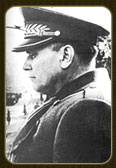
Tito is a translated royal work based on Tito by Phylis Auty. His Majesty translated this work to introduce his royal attendants to an important world figure, Josip Broz, known by his code name Tito, the former leader of Yugoslavia. The book covers his early life (born in 1892), his rise to power through the national liberation movement, and his widespread recognition for leading the resistance during World War I. Tito played a key role in uniting the ethnically, religiously, culturally, and historically diverse regions into a cohesive Yugoslav state after World War II and successfully guided the country through crises, maintaining its integrity and promoting national development throughout his life.
When Tito passed away at the age of 88 in 1980, divisions arose among the various ethnic groups within the country, and external enemies also emerged. As can be seen today, the absence of a leader like Tito had significant consequences. He was both a statesman and a remarkable, respected individual, widely acknowledged by nations around the world. From his story, we can also learn about the history of Europe and the world, as well as valuable lessons drawn from Tito’s life and leadership.
Literary Style in the Translated Royal Work Tito
Mr. Anan Panyarachun commented on His Majesty the King’s translation of Tito, stating that “It is a concise translation that skillfully preserves the substance and key points, while maintaining the excitement of the narrative. Anyone who has the opportunity to read this book will gain knowledge and enjoyment, and will also see that Tito was not merely an important historical figure, but a maker of history himself—shaping the unification and stability of a nation composed of diverse ethnicities, religions, cultures, and histories.”
The translated work Tito is a medium-sized book of only 121 pages, yet it is filled with elegant, graceful, and simple language that subtly conveys the distinctive literary skill of His Majesty the King, as evidenced in the following points.
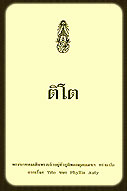
- 1. Art of Word Usage
1) Use of Colloquial Language (Vulgarism)
Colloquial language adds flavor to the text, giving readers a sense of liveliness and providing a clearer image of the characters than formal or standard language. Examples of colloquial usage in the text are as follows:
– “There are many unexpected aspects in him: a remarkably broad perspective, obvious freedom of thought, a constant sense of humor, unabashed appreciation for the simple pleasures of life, shyness in social interactions yet a friendly and sociable nature, occasional strong temper—sometimes explosive, sometimes delighting in showing off—compassion for others, and generosity.”
(Translated Royal Work: Tito, p.1)
– “He described himself as weak when he was a child, and indeed he seemed frail, with light-colored hair, a skinny frame, and a small body.”
(Translated Royal Work: Tito, p.8)
– “From his first earnings as a bicycle repairman, he bought a brand-new, fashionable outfit, intending to wear it when visiting homes.”
(Translated Royal Work: Tito, p.10)
– “At the end of the year (1944), he received news that Churchill and Stalin had reached a ‘fifty–fifty’ agreement, which placed Yugoslavia under the shared influence of the two countries—it was actually a temporary arrangement before the peace settlement, but Tito believed it to be permanent.”
(Translated Royal Work: Tito, p.100)
– “That period was a time of ‘settling accounts’ with political enemies, serving as the prelude to the final stage of operations.”
(Translated Royal Work: Tito, p.111)
– “This time the operation failed again, even though Tito was surrounded at the headquarters early on May 25, in the hut that served as his office and bedroom, adjacent to a natural cave in the cliff above the town.”
(Translated Royal Work: Tito, p.85)
2) Use of Thai Expressions
Even in translation, His Majesty the King employed Thai idiomatic expressions, allowing readers to fully absorb the flavor of the language without diminishing the original content. For example:
– “When entering adolescence—from twelve to fifteen years old—he had to work in this way. At first, he worked for his uncle, who raised him and promised a brand-new pair of boots as wages. By the age of fifteen, he had truly come of age.”
(Translated Royal Work: Tito, p.8)
– “The greatest difficulty Tito faced as party secretary arose from relations with the Comintern, which in reality was a relationship with the Russian overlords orchestrating through that organization.”
(Translated Royal Work: Tito, p.32)
– “I hope there will be a way to eliminate the quarrels between the two sides, for if not, it would only benefit the Germans.”
(Translated Royal Work: Tito, p.101)
– “The condition of the party worsened further when the Soviet government accepted Germany’s destruction of Yugoslavia as a fait accompli.”
(Translated Royal Work: Tito, p.51)
– “From the very beginning, when the Partisans took up arms, Tito assumed the dual role of military and political leader.”
(Translated Royal Work: Tito, p.89)
3) Use of Paired Words
The use of paired words is a distinctive feature in all of His Majesty the King’s translated works, including Tito, as exemplified below:
– “A harmless weakness was his lifelong fondness for stylish clothing.”
(Translated Royal Work: Tito, p.10)
– “Within two years, he went through many successive tasks.”
(Translated Royal Work: Tito, p.10)
– “Sabich was intelligent and personable, someone with whom Josip could converse and learn from.”
(Translated Royal Work: Tito, p.21)
– “He conducted bold and reckless agitation on the occasion of Labor Day celebrations in 1928.”
(Translated Royal Work: Tito, p.23)
– “He received many aliases during his illegal Communist activities, but the name he acquired in Vienna at that time was Tito, the name by which he became known.”
(Translated Royal Work: Tito, p.26)
– “He became even more aware of this importance, having witnessed many things.”
(Translated Royal Work: Tito, p.38)
– “The organization was still not well-structured and faced ongoing difficulties, as members weakened due to illness or arrest.”
(Translated Royal Work: Tito, p.43)
– “The Partisans prepared snow reception areas and built snow shelters, patiently waiting for Soviet planes to return, which never came.”
(Translated Royal Work: Tito, p.64)
4) Use of Compound Words
Compound words are another distinctive feature of the Thai language and of His Majesty the King’s translated works, as exemplified in Tito below.
– He learned to snatch, probe for food, and blend in without drawing attention. He became an expert in the art of evasion and escape.
(Translated Royal Work: Tito, p.14)
– The scent of victory began to spread, and with the hope of success, support for the Partisans increased day by day.
(Translated Royal Work: Tito, p.84)
5) The use of vocabulary
The use of words appropriate to the context of the story is essential, as it allows “word” and “meaning” to harmonize. Examples from the Translated Royal Work: Tito are as follows:
– It must signify that the struggle would bring about genuine freedom, equality, and fraternity for all nations in Yugoslavia. This is the essential substance of the fight for national independence.
(Translated Royal Work: Tito, p.63)
– After the establishment of the Proletarian Brigade, various decrees were issued as guidelines for the organization of the army.
(Translated Royal Work: Tito, p.78)
– The relationship between men and women was strictly regulated to be that of “comrades” only.
(Translated Royal Work: Tito, p.78)
– It was an occasion for a lively celebration, featuring a demonstration of fraternity.
(Translated Royal Work: Tito, p.100)
- 2. The Art of Rhetorical Expression
1) Simile
Simile is a rhetorical device frequently found in the Translated Royal Work: Tito, enhancing the elegance and expressiveness of the language, for example:
– I met a man of about fifty, strong in build, with gray hair and sharply defined features, though weary and tanned from the sun. His mouth revealed a resolute character, his light blue eyes were keen and alert. He had the look of one full of vigor, ready for immediate action, like a tiger poised to leap.
(Translated Royal Work: Tito, p.1)
– This task was more important than any other Tito had to undertake in Yugoslavia. For Tito himself, it was like being in hell, for he had to remain in the dangerous and tense atmosphere of Moscow, cut off from operations in his own country.
(Translated Royal Work: Tito, p.35)
– He began to feel encouraged as he thought of the dimly visible success ahead. “His blue eyes gleamed like steel, and his voice rang out with confidence and assurance.” He had no need to act as though he were confident in the future to hearten his subordinates.
(Translated Royal Work: Tito, p.95)
2) Metaphor
Metaphor is the use of suggestive expression that requires readers to interpret the underlying meaning for themselves. This type of rhetoric appears frequently in the Translated Royal Work: Tito, for example:
– Although born eight years before the dawn of this century, Tito was essentially a man of the modern age. The great events stained with blood—the two World Wars, the Russian Revolution, the Spanish Civil War, the rise and fall of Hitler and Mussolini, the massive Soviet purges of the 1930s–1940s, and the assassinations of notable figures at Sarajevo, Marseilles, and Dallas—all contributed to shaping his character and directly influenced his life.
(Translated Royal Work: Tito, p.2)
– During the celebration of the anniversary of the October Revolution, Josip Broz was one of the speakers and spoke of how the Russian workers achieved victory “through the power of the gun.”
(Translated Royal Work: Tito, p.18)
– Tito later said: “When I went to Moscow, I had no way of knowing that I might be awakened in the middle of the night to hear the sound of the death knock on the door.”
(Translated Royal Work: Tito, p.33)
– He learned that the Soviet leaders regarded individuals as expendable, ruling with cruelty, ruthlessness, and inhumanity, forcing blind obedience to policies that were never explained.
(Translated Royal Work: Tito, p.37)
– He would certainly receive support from the Soviet Union, for was not the expansion of the revolution one of the aims of international communism? This principle had been instilled in him for many years. How the war would proceed was uncertain, and when the golden opportunity would arrive remained unknown.
(Translated Royal Work: Tito, p.41)
– That meeting served as a demonstration of the difficulties involved in what was called “conspiracija,” meaning underground secret operations.
(Translated Royal Work: Tito, p.45)
– The German army had already seized the oil fields in Romania, and the leaders of Eastern European countries were under intense pressure to join the Tripartite Pact of Germany, Italy, and Japan.
(Translated Royal Work: Tito, p.45)
– Only half of the mobilization had been achieved, and the troops were poorly armed to resist the tactics of the Blitzkrieg and the superior weaponry of the Germans.
(Translated Royal Work: Tito, p.48)
– This state then became part of the new political system under the leadership of the puppet ruler, Ante Pavelic.
(Translated Royal Work: Tito, p.49)
– Even with his hands tied by Russia, it was already evident that Tito possessed the qualities of an independent leader.
(Translated Royal Work: Tito, p.51)
– The Jajce Conference was a turning point in Tito’s political strategy during the war. It was a masterpiece of foresight and execution, marked by the courage that became his hallmark.
(Translated Royal Work: Tito, p.96)
– “The Big Three” made no mention of Yugoslavia’s political future, but by now it was clear that Tito and the Partisans were a force to be reckoned with in postwar negotiations.
(Translated Royal Work: Tito, p.103)
– Tito was dissatisfied with this agreement, as it limited his authority and curtailed his freedom to conduct political affairs in Yugoslavia as he had done with his comrades over the past three years. The sweet dream of the Partisans during the war had now come to an end.
(Translated Royal Work: Tito, p.105)
– You may think that simply because we are allied with the British we have forgotten who they are—and who Churchill is. Nothing pleases them more than playing tricks on their allies… And as for Churchill, he is the sort of man who would pick a pocket for even a single kopeck if one were not careful.
(Translated Royal Work: Tito, p.109)
– Before long, the Partisans began to feel disillusioned with their Soviet allies, who conducted themselves as an undisciplined “liberation army.”
(Translated Royal Work: Tito, p.110)
– Stalin remarked: “You need not accept the King permanently—let him return only temporarily, and later you can stab him in the back at the proper time.”
(Translated Royal Work: Tito, p.113)
– Anyone could stand as a candidate for election, except those deemed “enemies of the people.” All citizens, both men and women over the age of eighteen, had the right to vote, as did youth under eighteen.
(Translated Royal Work: Tito, p.117)
3) Antithesis
The expression of contrasting ideas is a form of linguistic sharpness that enhances the distinctiveness of ordinary language. The following are examples of this rhetorical device found in the Translated Royal Work: Tito.
– As time passed and experience grew, Tito’s outlook broadened, and his rigidity diminished. Freed from the constraints of Moscow, he became more willing to experiment and to learn from the experiences of others. His sense of humor, a useful asset, increased. As a person, he became less harsh, gentler, less impulsive, and more even-tempered—less of a dictator and more of a human being. Yet he never abandoned the strength and sharpness of character that had sustained him in the past.
(Translated Royal Work: Tito, p.2)
– Instead of surrendering or allowing his nation to be gradually absorbed, he preserved within himself a fierce hatred of the existing social system and a deep and passionate love of freedom.
(Translated Royal Work: Tito, p.5)
– Hitler failed to take into account the temperament of the Yugoslav people. The policy of “divide and rule” ultimately worked to Germany’s disadvantage.
(Translated Royal Work: Tito, p.50)
– It was the final attempt at joint resistance between the Partisans and the Chetniks. After this, their relations rapidly deteriorated.
(Translated Royal Work: Tito, p.60)
- 4. Personification
This rhetorical device allows readers to attribute human characteristics and emotions—familiar qualities of people—to things that have neither feeling nor consciousness, for example:
– His duty was to reorganize the Party’s political work in Yugoslavia in an effort to revive it from its near-death condition.
(Translated Royal Work: Tito, p.29)
– Nevertheless, it may be said that being left alone and isolated, able to carry out his own revolution without interference from any great power, was a crucial factor in the significance of the communist revolution in Yugoslavia. Thus, Tito shaped the nationalistic and independent form of communism into a political structure of incomparable character. In this way, “Titoism” became strong enough to withstand later confrontations with the Soviet Union.
(Translated Royal Work: Tito, p.120
- 5. Hyperbole
Hyperbole is the use of exaggeration to convey a sense of seriousness, abundance, or grandeur. In the Translated Royal Work: Tito, examples of hyperbole include:
– The entire Partisan movement felt indescribable joy at the miraculous success achieved. Everyone agreed that no praise was excessive for the army that had brought about this accomplishment.
(Translated Royal Work: Tito, p.87)
– He expected everyone to work with all their strength until death, just as he himself did, and during the war, everyone under his command did precisely that.
(Translated Royal Work: Tito, p.119)
(Chamnarn Rodhetphai, 2002: 183-190)
Therefore, to fully appreciate this book for both knowledge and enjoyment, one must read slowly and reflectively. In doing so, readers gain insight, moral lessons, and great pleasure. His Majesty the King was truly a genius in the literary arts. The Royal Work: Tito, spanning 121 pages, has been published no fewer than nine times (the 9th edition in 1995 totaling 90,000 copies), with all proceeds donated to the Chaipattana Foundation.
2.4.4 The Royal Work: Phra Mahachanok
His Majesty King Rama IX listened to the Dharma sermon on Phra Mahachanok delivered by Somdet Phra Maha Wirawong (Win Dhammasaro Mahathera) of Wat Ratchapradittharam in 1977. Deeply interested, He conducted further research on Phra Mahachanok in the Tipitaka.
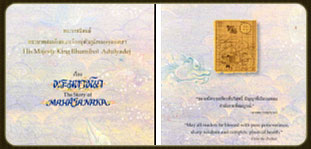
His Majesty King Rama IX completed the translation of the Mahajanaka Jataka in 1988 and graciously authorized its publication on the occasion of the Golden Jubilee of His Reign (50th anniversary) to serve as a guide for the moral conduct and benefit of the public (excerpted from the Preface of the Royal Work: Phra Mahachanok, 1997: 6, 8).
His Majesty King Rama IX composed the Buddhist Jataka tale, Phra Mahachanok, as an example of diligent practice in doing good deeds and as a means to liberate oneself from suffering, as stated to the press on 28 March 1996.
“The main idea of this Jataka tale is to show that perseverance is essential above all. Whatever one undertakes must be done with diligence. Even if the shore is not in sight, one must continue to swim, and the value of such effort becomes evident. For if one does not persevere in swimming for seven days and seven nights, one will not encounter the deities. Those who lack perseverance will sink and become food for the turtles’ fish. Therefore, even without knowing when the shore will be reached, one must persist in swimming…”
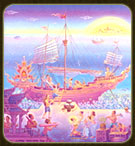
Phra Mahachanok traveled by boat to trade in the land of Suvarnabhumi.
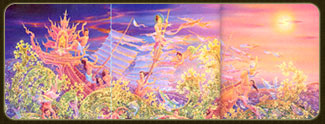
The boat sank in the middle of the sea.
Phra Mahachanok is a Royal Work entirely composed by His Majesty King Rama IX. He adapted certain parts to make the story easier to understand and suitable for contemporary society. The work consists of 37 chapters and narrates the story of Phra Mahachanok, one of the ten previous lives of the Buddha. He embarked on a voyage by boat to trade in the prosperous land of Suvarnabhumi, but the boat sank in the middle of the sea. Crew members who lacked perseverance in swimming perished in the water.

Phra Mahachanok showed great perseverance.
Only Phra Mahachanok persevered in swimming for seven days and seven nights, until Nang Mani Mekhala found him and rescued him, ensuring his survival.
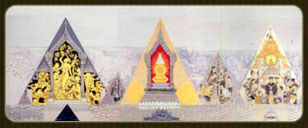
He also incorporated writings on nature conservation, agriculture, and comprehensive education into the narrative.
The Art of Language
His Majesty King Rama IX possessed extraordinary linguistic skill, as evidenced by his numerous Royal Works written in a highly artistic style. In particular, the Royal Work: Phra Mahachanok demonstrates His Majesty’s mastery of three languages: Thai, English, and Devanagari. He first translated the Thai Mahajanaka Jataka directly into English. The Mahajanaka Jataka is a story found in the Tipitaka, Sutta Pitaka, Khuddaka Nikaya, Jataka, Volume 4, Part 2.
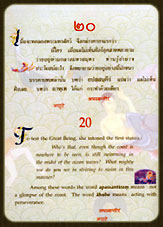
Anand Panyarachun once remarked on the linguistic mastery of His Majesty King Rama IX: “…He graciously composed his Royal Work in English as well, allowing us to compare the meanings in both languages clearly. It can also serve as a textbook for language learning and enables his work to be disseminated worldwide. He is a writer recognized globally, and his Royal Works will greatly contribute to the enduring happiness and prosperity of people around the world.”
His Majesty King Rama IX employed language with meticulous care in the Royal Work: Phra Mahachanok. This can be seen from His Majesty’s own remarks when the work was first published. At that time, He graciously received the committee responsible for the publication and presented them with a replica of the Phra Mahachanok gold medal. He also spoke about the use of language in the Royal Work: Phra Mahachanok, stating in part:
“…This book consists of several parts. The first part, in Thai, comes directly from the Tipitaka, using the original words as they appear. The second part has been adapted so that certain expressions or words that are outdated or may not be useful to contemporary readers are revised to benefit modern society. The English sections are direct translations from the Thai, which includes both the original and the newly adapted material… The language may seem unusual because it reflects the ancient story or contains some enigmatic expressions. Those who understand English may need to refer to the Thai text to grasp the meaning of the English, and those who know Thai may sometimes consult the English to see how the Thai has been rendered. This is beneficial for language learners and also serves to refine the Thai language for native speakers. Additionally, the work has been transcribed in the ancient script, Devanagari, which is very challenging because so few people know this language; great care is needed to ensure accuracy and satisfaction… The revisions of this book are not yet complete… but the work must continue diligently. Corrections have been made to the Thai text where errors existed and to some English parts where grammatical issues may occur. Discussions and revisions were made, and Her Royal Highness Princess Maha Chakri Sirindhorn assisted for two days and two nights along with her colleagues…”
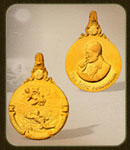
Replica of the Phra Mahachanok gold medal
The careful use of language by His Majesty the King, as described above, can be analyzed in terms of his literary artistry as follows:
1. Use of Archaic Language (Obsolete)
Since the story of Phra Mahachanok is ancient, His Majesty employed archaic language, especially in the dialogue of the characters.
– At that time, there was a Brahmin skilled in incantations from Kalanjampaka, a Tisapamok Manap, surrounded by approximately five hundred men, walking together to bathe.
(Royal Work: Phra Mahachanok, p.30)
– Upon seeing him, she felt an inexplicable affection as if he were her brother.
(Royal Work: Phra Mahachanok, p.30)
– “Which village is your mother from?” the princess asked. The queen replied, “Father, my father is the chief queen of King Arittachana of Mithila.”
(Royal Work: Phra Mahachanok, p.32)
– “You shall say to me, ‘You are my brother,’ and then clasp my feet and weep.”
(Royal Work: Phra Mahachanok, p.32)
– “Fathers, this woman is my sister.”
(Royal Work: Phra Mahachanok, p.34)
– The princess bestowed a name upon her son, as her father had, calling him Mahachanok Kumara.
(Royal Work: Phra Mahachanok, p.38)
– “You need not tell us; leave it as you wish.”
(Royal Work: Phra Mahachanok, p.42)
– “Mother, please tell my father.”
(Royal Work: Phra Mahachanok, p.43)
– “…This Brahmin placed the mother in the role of a younger sister and cared for her.”
(Royal Work: Phra Mahachanok, p.43)
– He leaped from the top of the mast, passing over schools of fish and turtles, and finally fell into a whirlpool.
(Royal Work: Phra Mahachanok, p.58)
– “If Phra Mahachanok dies, we shall not enter the assembly of deities.”
(Royal Work: Phra Mahachanok, p.66)
– Thinking thus, he adjusted his form and remained suspended in the air, not far from the great being.
(Royal Work: Phra Mahachanok, p.66)
– “I have swum across the great ocean for seven days and nights. Today, I have seen none of my two friends. Who is this speaking to me?”
(Royal Work: Phra Mahachanok, p.69)
– When the king intended to make Nang Mani Mekhala yield to his words… “Behold, deities.”
(Royal Work: Phra Mahachanok, p.86)
– “All of you shall confer the kingdom upon the one who can please Vali Devi, our daughter.”
(Royal Work: Phra Mahachanok, p.102)
– The priest said that the royal chariot (Phussarat) should be released, for the king who summoned it is the one capable of ruling the entire Jambudvipa.
(Royal Work: Phra Mahachanok, p.108)
– The minister was given the first opportunity, but he could not delight the princess.
(Royal Work: Phra Mahachanok, p.108)
– The people, including the nobles and priests, celebrated the coronation of the great being at that very place.
(Royal Work: Phra Mahachanok, p.108)
– All the citizens of Vitharata rejoiced exuberantly and celebrated with grand musical festivals.
(Royal Work: Phra Mahachanok, p.113)
– “Behold, chief gardener, I wish to see the garden; you shall arrange it accordingly.”
(Royal Work: Phra Mahachanok, p.120)
The archaic words in the passages above, such as ผู้เพ่งมนต์ (a person strict in reciting incantations), ทิศาปาโมกข์ (a master of philosophy), มาณพ (person), สิเนหา (affection), ราวกะว่า (as if), แม่ – พ่อ (respectful forms of address for women and men), กล่าวกะ (speak to), ขนานนาม (name or give a title), ยกไว้เถิด (leave it aside or forget it), อุสภะ (an ancient unit of distance, 1 sen = 15 wa ≈ 70 meters), เทวสมาคม (assembly of deities), มหาสัตว์ (bodhisattva), เพื่อนสอง (personal spirit or guardian spirit), ดูก่อน (an expression to call attention before speaking), ยังให้ยินดี (to please or delight), ผุสสรถ (royal chariot), เสนาบดี (chief minister), อมาตย์ (courtier), ปุโรหิต (privy counsellor), เอิกเกริก (tumultuous or exuberant), and อุทยานบาล (gardener or caretaker), among others, are highly suitable for the context of the narrative, as they align seamlessly with the historical and cultural setting of the story, reflecting the language, social hierarchy, and worldview of the period in which the events take place.
2. Use of Colloquial or Spoken Language (Colloquial)
Spoken or colloquial language brings the story to life and creates realism. Ordinary characters speak in everyday language, sometimes using correct or incorrect royal forms, as in the following examples:
– “Elder brother … younger brother …”
(Royal Work: Phra Mahachanok, p.1)
– “Your Highness, the Deputy King has been dishonest toward His Majesty.”
(Royal Work: Phra Mahachanok, p.4)
– “At that place, the people recognized him and took care of His Majesty; at this moment, Arittachanak could not seize him.”
(Royal Work: Phra Mahachanok, p.5)
– Even in broad daylight, no one recognized Her Majesty.
(Royal Work: Phra Mahachanok, p.14)
– “Mother, who is my father?”
(Royal Work: Phra Mahachanok, p.42)
The colloquial or spoken expressions in the examples above include elder brother … younger brother … (formal equivalent: royal terms = chestha–anucha), dishonest (betrayal or rebellion), recognized him (recognized His Majesty), broad daylight (bright daytime), and my father (referring to one’s father in a respectful form). These reflect realism, as the language is sometimes correct, sometimes not, blending formal and informal usage throughout.
3. Use of Royal Vocabulary
Since the main characters are royalty, the text appropriately employs royal vocabulary to maintain authenticity, as in the following examples:
– “Mother, I shall go to Suvarnabhumi.”
(Royal Work: Phra Mahachanok, p.51)
– On that day, illness befell King Polachanag; after lying down, he could not rise again.
(Royal Work: Phra Mahachanok, p.51)
– The Brahmin responded to the royal command: “The royal decree is unquestionable; the deities would call it ‘Bodhiyalai,’ the name of the hermitage institute at Wat Phra Chetupon in the divine city of Suvarnabhumi. However, calling it ‘Putalay Mahawitthayalai’ would also be appropriate.”
(Royal Work: Phra Mahachanok, p.140)
4. Use of Language According to Thai Social Conventions
The use of spoken language reflecting Thai social norms in this royal work creates an authentic Thai social atmosphere, as shown in the following examples:
– “Beloved, whether the battle is lost or won cannot be known. If you are in danger, you must protect the womb carefully.”
(Royal Work: Phra Mahachanok, p.12)
– “Father, I shall go.” King Sakra said: “Then mother, please rise and sit on the cart.”
(Royal Work: Phra Mahachanok, p.22)
– Asked, “Teacher, what has happened to you?”
(Royal Work: Phra Mahachanok, p.34)
In Thai interpersonal communication, people often address each other in familial or respectful terms to convey friendliness or honor important individuals, as in beloved, elder brother/younger brother (used between spouses), Father (used respectfully even when not literally a parent), and Teacher (adding “ท่าน” / “Mr./Respected” to show greater respect).
5. Use of Technical Terms
In addition to the use of royal vocabulary, the royal work Phra Mahachanok also employs a vast array of technical terms related to Buddhism, governance, and specialized fields, such as Muan Chon (the mass of people = mass population), Yutthopokorn (war equipment = military equipment), Kong Banchakam (headquarters), Mahasat (the Great Being = Bodhisattva), Thit Thaksin (the southern direction), Antewasik (disciples), Nives (home or dwelling), Mana (pride or self-esteem), Prathaksin (circumambulation to the right), Marana Phai (danger from death), Mahachon (the general public = public), Phaksa (food), Phra Pha-ha (arm), as well as other terms such as Thipayasambat, Thepsamakom, and Patipatha (behavior), and the use of these specialized terms reflects the meticulousness, cultural depth, and the combination of religious, political, and social elements in the royal narrative, making the work both comprehensive and culturally profound.
The terms include Anisong Dhammakatha (meritorious effect; moral teachings), Anisong Adirek Katha (additional explanatory statements), Vacha An Mi Patiharan (words with miraculous or profound meaning), Atthapap / Atthapap Thip (divine or celestial body), Sadap Phra Waja (listening to the teachings of the Buddha), Phra Sreera Saromong (somber or sorrowful bodily state), Thipayasambat (divine or supernatural possessions), Thaen Marana Manja Asana (death bed or mortuary bed), Manasikara (contemplation or reflection), Phoka (wealth), Paccakka Buddha (self-awakened Buddha), Yantakal (automatic fruit harvester), and Chiwanu Songkroh (cell culturing or tissue culture), among others, which are specialized technical terms drawn from Buddhist, moral, agricultural, and scientific contexts to convey precise meaning in the narrative.
– Then they moved the army to the city of Mithila, accompanied by a large mass of people.
(Royal Work: Phra Mahachanok, p.8)
– They carried military equipment, including elephants and other vehicles, to the headquarters of King Polachanok.
(Royal Work: Phra Mahachanok, p.9)
– The creature in the womb of the goddess was not an ordinary being, but a Great Being (a fully accomplished Bodhisattva) who had been reborn.
(Royal Work: Phra Mahachanok, p.20)
– At that time, King Sakka Devaraja had the goddess descend from the chariot near the gate on the southern side.
(Royal Work: Phra Mahachanok, p.30)
– Then the disciples heard the sound of the Brahmin and ran into the hall.
(Royal Work: Phra Mahachanok, p.34)
– The Brahmin attended to the goddess in his residence.
(Royal Work: Phra Mahachanok, p.38)
– He possessed great strength, and because he was strict due to mana (self-pride), being born in a pure royal lineage.
(Royal Work: Phra Mahachanok, p.39)
– Bidding farewell to his mother, he paid respects and performed prathaksin (circumambulation).
(Royal Work: Phra Mahachanok, p.51)
– The public feared death danger (maranaphai) and cried, lamenting, and worshipped all the deities.
(Royal Work: Phra Mahachanok, p.58)
– The public became food (phaksa) for the fish and turtles.
(Royal Work: Phra Mahachanok, p.58)
– He crossed the great ocean with the strength of his arms (phrapha).
(Royal Work: Phra Mahachanok, p.58)
– The public (mahachon) became food (phaksa) for the fish and turtles.
(Royal Work: Phra Mahachanok, p.58)
– He crossed the great ocean with the strength of his arms (phrapha).
(Royal Work: Phra Mahachanok, p.58)
– She enjoyed the divine treasures (thipayasambat) and became careless, failing to pay attention; some scholars said she, a goddess, went to the assembly of deities (thepsamakhom).
(Royal Work: Phra Mahachanok, p.66)
– “Listen, O deities, I have contemplated the behavior (patipata) of the world and the merit (anissong) of perseverance…”
(Royal Work: Phra Mahachanok, p.69)
– Manimekhala desired to hear the Dhamma discourse (thammakatha) of the Great King.
(Royal Work: Phra Mahachanok, p.75)
– The deities then spoke an additional explanatory verse (adirekkatha): “O wise one, the miraculous words (wacha anupathiharn) must not vanish into the air; you must let the faithful receive the knowledge of Bodhi from your mouth. At the proper time, establish an educational institution named Bodhiyalai Mahavidhyalai. Only then will your work be truly accomplished.”
(Royal Work: Phra Mahachanok, p.96)
– “Observe the results of our perseverance; never before have I seen a deity in this form (atthapap)—now I have seen you appear near me in this divine form (atthapap thip).”
(Royal Work: Phra Mahachanok, p.88)
– The deities listened to the firm words of the Great Being (mahasat) .
(Royal Work: Phra Mahachanok, p.94)
– The Great Being had a sorrowful body from the salt water for seven days; when he touched the divine sensations (thipayaphassa), he fell asleep.
(Royal Work: Phra Mahachanok, p.96)
– King Polachanraj lay on the death bed (thana moranamanja asana).
(Royal Work: Phra Mahachanok, p.102)
– The Great Being reflected on the efforts he had made in the great ocean and contemplated (manasikara) that things he did not expect could happen, and what he planned might fail; all the wealth (phoka) of women and men could not be achieved by mere thought alone.
(Royal Work: Phra Mahachanok, p.113)
– The Great Being practiced the ten royal virtues (thosapitharajadharma), ruled the kingdom righteously, and supported all the individual Buddhas (paccakkha Buddha).
(Royal Work: Phra Mahachanok, p.117)
– “… I therefore used the automatic fruit harvester (yantaka) without thinking it would uproot the mango trees …”
(Royal Work: Phra Mahachanok, p.132)
– “… practiced cell culture (chiwanausangkra) …”
(Royal Work: Phra Mahachanok, p.132)
– “… Now I hesitate and wonder if it is correct. O teacher, Master of Philosophy (thitapamok) please reveal your contemplation (manasikara).”
(Royal Work: Phra Mahachanok, p.136)
6. Use of Elevated Vocabulary
The royal work Phra Mahachanok is a highly elevated text because it involves a king who is a Bodhisattva and deities. Therefore, some passages use high-level vocabulary that conveys elegance and grandeur when read. Examples include:
The queen reclined to rest, as she lay upon a divine bed.
(Royal Work: Phra Mahachanok, p.23)The queen accepted the command, spoke loudly, and lowered herself to hold the priest’s feet; both of them wept and lamented.
(Royal Work: Phra Mahachanok, p.34)The priestess had the queen bathe and refresh herself in warm water, then arranged her bed for resting.
(Royal Work: Phra Mahachanok, p.36)He/She possessed perfect and full beauty.
(Royal Work: Phra Mahachanok, p.4)Then they were loaded onto the ship along with the merchants traveling to Suvarnabhumi.
(Royal Work: Phra Mahachanok, p.50)
It is noteworthy that the rare and unusual vocabulary in this work contributes to making the language of the literature exceptionally elegant and refined, rather than plain or ordinary, as seen in expressions such as “recline to rest” (lie down), “sleep on a divine bed” (lie on a comfortable bed), “lower oneself gracefully”, “weep and lament together”, “bathe and refresh oneself”, “place of rest”, “perfect and full beauty” (handsome or beautiful appearance), and “merchants” (traders), all of which enhance the literary beauty and convey a sense of sophistication beyond common narrative style.
7. Use of Explanatory Notes for Difficult Passages
The dialogues between Phra Mahachanok and Nang Mani Mekhala are particularly important because they convey the highest ideals and key concepts of this royal literary work. King Bhumibol Adulyadej highlighted essential passages by selecting key words and providing explanations in both Thai and English to help readers understand them more easily. For example:
– บรรดาบทเหล่านั้น บทว่า อปสฺสนฺตีรํ แปลว่า แลไม่เห็นฝั่งเลย . บทว่า อาหุเห ได้แก่ กระทำด้วยความเพียร
(พระราชนิพนธ์เรื่อง “ พระมหาชนก ” หน้า 68)
– Among these words the word apassantiram means : not a glimpse of the coast.The word ahuhe means : acting with perseverance.
(พระราชนิพนธ์เรื่อง “ พระมหาชนก ” หน้า 70)
– บรรดาบทเหล่านั้น บทว่า นิสมฺม วตฺตํ โลกสฺส ความว่า เรานั้นไตร่ตรอง คือ ใคร่ครวญ วัตร คือ ปฏิปทาของโลกอยู่. บทว่า วายมสฺส จ ความว่า พระมหาสัตว์แสดงความว่าเราไตร่ตรอง คือ เห็นอานิสงส์แห่งความเพียรอยู่.
(พระราชนิพนธ์เรื่อง “ พระมหาชนก ” หน้า 69)
– Among these words, the words nisamma vattam lokassa mean : we have reflected upon,i.e.thought out,the duties.i.e. the behaviour of the world. The words vayamassa ca mean : the Great Being exposes his view : we have reflected,i.e.we have seen the merits of perseverance.
(พระราชนิพนธ์เรื่อง “ พระมหาชนก ” หน้า 70)
From these examples, it is clear that the core ideas of the text are conveyed through the key words: apassantiram = not a glimpse of the coast, ahuhe = acting with perseverance, nisamma vattam lokassa = reflecting upon the duties or conduct of the world, and vayamassa ca = perceiving the merits of perseverance.
These words are “key terms” that King Bhumibol Adulyadej intended to emphasize particularly, so he first presented the passages in Pali and then provided explanations of their meanings. Moreover, he also included Devanagari script that he personally created using computational tools, further highlighting the importance of these key words. This approach is one of the distinctive features of this royal literary work.
For example, the word Bodhiyalai means: a dwelling of light, and the word Mahavidhyalaya means: a dwelling of great knowledge. The Great Being had a weary body from the saltwater for seven days, but upon touching divine sensations, he rested and slept. Subsequently, Nang Mani Mekhala brought the Great Being to Mithila city, laid him to rest on a sacred stone slab in a mango grove, assigned the deities in the garden to guard him, and then returned to her own dwelling.
Reading the English translation alongside the original text sometimes helps to understand the meaning of key terms more easily, as the King himself explained, for instance:
อปสฺสนฺตีรํ apassantiram means : not a glimpse of the coast.
อาหุเห ahuhe means : acting with perseverance.
นิสมฺม วตฺตํ โลกสฺส nisamma vattam lokassa mean : we have reflected upon i.e. thought out,the duties,i.e. the behaviour of the world.
วายมสฺส จ vayamassa ca mean : the Great Being exposes his view : we have reflected, i.e. we have seen the merits of perseverance.
8. Use of Elegant Language
The language in the royal literary work Phra Mahachanok is notable for its elegance, employing wordplay, paired expressions, and more refined diction than ordinary language. This can be observed in the following examples:
– Other citizens of the city came to pay homage.
– Any undertaking that is not carried to completion through effort will yield no result.
– Efforts made in an improper capacity, until death appears, what use is such endeavor?
– Whoever has perfect effort in accordance with righteousness, not sinking into the immeasurable ocean, and sees thus through the deeds of human perseverance, let that person go to the place that pleases their heart.
– From the viceroy to the elephant and horse keepers, and from the horse and elephant keepers to the viceroy, and especially the courtiers, all wandered in the realm of illusion.
It is clear that the use of the term citizens of the city conveys a more elegant nuance than the ordinary word people.
The use of paired words in the text further enhances the elegance and adds color to the language. Examples include: any…that, any improper…that improper, whoever…that person, and constructions like from…(high rank)…to…(low rank) and from…(low rank)…to…(high rank), which create a rhythmic and sophisticated style unique to this work.
Art of Rhetoric
The use of figurative language or stylistic devices is a prominent literary feature throughout the royal literary work Phra Mahachanok. It enhances the beauty of the text, stimulates imagination, and allows readers to understand the story more vividly and deeply. Among the most frequently used figures of speech in Phra Mahachanok are similes.
1. Use of Simile
A simile is a figure of speech that compares one thing to another, creating clear imagery and strengthening the reader’s imagination. Examples from the text include:
– The prince was born with a complexion like gold.
– The surrounding water was red like blood.
– The Great Being moved through waves colored like jeweled glass, resembling the stalk of a golden banana plant.
– She lifted the Great Being as one would carry a bouquet, holding him close to her chest with both arms, flying through the air like a person cradling a beloved child.
– Another mango tree stood beautifully, like a mountain adorned with jeweled plants.
– He reflected: “This tree remains fresh and green because it bears no fruit, whereas this tree was felled because it bore fruit. Likewise, royal power is like a tree that bears fruit, while ordination is like a tree without fruit. Danger comes to those who are concerned, but it does not come to those who are free from worry. Therefore, I shall not be like a tree that bears fruit; I shall be like a tree without fruit.”
(Royal Work: Phra Mahachanok, p. 124)
(พระราชนิพนธ์เรื่อง “ พระมหาชนก ” หน้า 124)
The main statement (tenor) and the statement used for comparison (vehicle) often share a relationship or common characteristics. From the above example, the analysis is as follows.
tenor
– Yellow-colored skin
– Red-colored water
– Color of the waves
– The Great Being (Bodhisattva)
– The manner of carrying
– The manner of supporting
– The way it stands beautifully
– Royal possessions
– Ordination
similes
– Like gold
– Like blood
– Like gem-colored waves
– Like a golden banana tree
– Like a person carrying a bouquet of flowers
– Like someone cradling a beloved child
– Like a mountain adorned with jewels
– Like a fruit-bearing tree
– Like a tree without fruit
2. Use of Metaphor
Metaphor is a literary device that requires the reader to think about what the words truly signify. It serves as a means to enhance the reader’s imagination effectively. Examples of this type of figurative expression can be found in the royal literary work Phra Mahachanok, such as:
-“Sometimes it feels as if one is stepping on the seabed, almost reaching the shore, like the sixth person among seven persons (in the Utkupma Sutta No. 5). But in reality, it is a giant sea crab.”
(Phra Mahachanok, p. 136)
– The affection of the king toward his younger brother could not endure the repeated “poisonous words.”
(Phra Mahachanok, p. 4)
– “Beloved child, your mother did not come empty-handed …”
(Phra Mahachanok, p. 46)
From the above examples, the term giant sea crab is a metaphor, where the reader must infer its meaning from the surrounding text, suggesting the King’s merit or good deeds. The phrase poisonous words can be understood as words that appear good on the surface but are actually harmful. The expression did not come empty-handed is generally understood to mean that the person brought wealth or possessions with them.
3. Use of Personification
Personification is the literary technique of giving abstract concepts or inanimate objects human-like qualities. In Phra Mahachanok, this can be seen in examples such as:
– Whoever realizes that this task, even with perseverance, cannot be completed or achieved, and yet does not remove the wild and raging elephants, is said not to preserve one’s own life.
(Phra Mahachanok, p. 87)
– He disguised himself with old and faded robes.
(Phra Mahachanok, p. 14)
– The ship sailed with the force of a violent wave and could not maintain its balance.
(Phra Mahachanok, p. 58)
The personification in the above example uses terms like wild elephants and raging elephants as metaphors for human emotions—specifically, krodha (anger) and moha (delusion)—which are abstract concepts. By describing them as wild and raging elephants, the reader can visualize the ferocity and danger of these human emotions. Similarly, old and faded robes convey the wearer’s feelings, as the king has imbued the clothing with human emotion. The phrase violent waves attributes human-like qualities to nature; just as a vicious person is dangerous, so too are the waves.
4. Use of Hyperbole
Hyperbole is a figure of speech that exaggerates beyond reality, giving vivid flavor to language without implying falsehood. In Phra Mahachanok, hyperbole appears in several instances, for example:
– “Once upon an uncountable time past.”
(Phra Mahachanok, p. 1)
– By the power of His Royal Son, when the queen was about to ascend the chariot, the ground swelled up to the rear of the chariot.
(Phra Mahachanok, p. 23)
– When a person acts with perseverance, even if he dies, he is said not to owe anything to relatives, deities, or parents; moreover, one who acts as a righteous man will not suffer afterward.
(Phra Mahachanok, p. 79)
– The Great Being swam across the ocean for seven days, as if swimming for only a single day.
(Phra Mahachanok, p. 58)
– When the prince of the great king grew up, he was granted the coronation of the crown prince and then reigned for seven thousand years.
(Phra Mahachanok, p. 117)
– The troops of Aridṭhachanok were ruthlessly cut down by the soldiers of Polachanok, and he himself lost his life in battle.
(Phra Mahachanok, p. 14)
– The fruit was extraordinarily sweet… when the mango was placed at the tip of the Great Being’s hand, it appeared as if tasting celestial nectar.
(Phra Mahachanok, p. 121)
The richness of the language arises greatly from hyperbole. For example, phrases like “once upon an uncountable time past” evoke a sense of an immeasurable span of time. “The ground swelled up to the rear of the chariot” conveys miraculous power, symbolizing the human spirit’s ability to ease even heavy tasks. “Even if one dies while persevering, one is said not to owe anything to relatives, deities, or parents” illustrates the value of genuine effort—though benefits may not be immediate, one hopes to leave no debt behind. “Swam across the ocean for seven days as if for one” emphasizes the immense inner strength of someone steadfast in perseverance. “Reigned for seven thousand years” signifies a very long reign, not an actual count of years. “Ruthlessly cut down” allows the reader to vividly imagine total defeat without taking the words literally. “Extraordinarily sweet, like celestial nectar” conveys an incomparable sweetness, beyond any earthly fruit, highlighting the need for an extraordinary comparison—no mortal tongue could truly measure it.
5. The Use of Allusion
Allusion is the literary technique of incorporating stories, fables, or familiar events to help readers better understand the happenings within the narrative. Examples from Phra Mahachanok include:
– “… Since the time of boarding the ship toward Suvarnabhumi, before the giant waves struck the vessel, we heard the merchants of Suvarnabhumi speaking in their language: ‘There, the giant crab fights with the fish and the turtle.’ And whoever steps on that crab will become great, if they have true perseverance.”
(Phra Mahachanok, p. 136)
Using familiar tales as comparisons within the story is a narrative technique that enriches the reader’s imagination. It connects prior knowledge or experiences to new events that share similar characteristics. For instance, the Suvarṇabhūmi fable of the giant crab fighting fish and turtles is used to illustrate the perseverance of Phra Mahachanok. Ultimately, through merit and the fruits of his efforts, he avoids being swept away and eaten by the sea like others.
English Version of Phra Mahachanok: Mahajanaka
King Rama IX composed the English version of Phra Mahachanok (Mahajanaka) before the Thai version. A comparison of both versions shows that the content aligns consistently throughout. Even the style of rhetorical devices and sentence structure largely correspond from the first page to the last.
1. Language in the Opening of the Story
ในอดีตกาลอันพ้นคณนาวิสัยครั้งหนึ่ง พระราชาพระนามว่า มหาชนก ครองราชสมบัติอยู่ใน กรุงมิถิลาแคว้นวิเทหะ . พระเจ้ามหาชนกนั้น มีพระราชโอรสสองพระองค์ พระนามว่าอริฏฐชนก และโปลชนก. พระราชาพระราชทานตำแหน่งอุปราชแก่องค์พี่ และตำแหน่งเสนาบดีแก่องค์น้อง. กาลต่อมาพระมหาชนกราชสวรรคต . พระอริฏฐชนกได้ครองราชสมบัติและทรงตั้งพระโปลชนกเป็นอุปราช
(พระราชนิพนธ์เรื่อง “ พระมหาชนก ” หน้า 1)
Once upon an uncomputable time past, there was a king bearing the name of Mahajanaka who reigned in the city of Mithila in the land of Videha. King Mahajanaka had two sons named respectively Aritthajanaka and Polajanaka. The elder son was invested by the King as Viceroy, and the younger one, Chief Minister. In the course of time, the King passed away to Heaven. Prince Aritthajanaka acceded to the throne and invested his brother as Viceroy.
(The story of Mahajanaka , p.1)
2. Language in the Development of the Story
The styles of both languages are expressive and engaging, with the English version often using elegant expressions that differ from the Thai text. For example:
– ไพร่พลของพระอริฏฐชนกถูกพระโปลชนก ตะลุยหั่นแหลก
(พระราชนิพนธ์เรื่อง “ พระมหาชนก ” หน้า 14)
– In the battle that ensued, Prince Polajanaka’s soldier made mince meat of Aritthajanaka’s and killed him.
(The story of Mahajanaka , p.15)
– สัตว์ที่เกิดในพระครรภ์ของพระเทวีมีบุญมาก
(พระราชนิพนธ์เรื่อง “ พระมหาชนก ” หน้า 20)
– The Being in the royal womb has a great destiny.
(The story of Mahajanaka, p.15)
– ทิศาปาโมกข์ มาณพประมาณห้าร้อยคนแวดล้อม
(พระราชนิพนธ์เรื่อง “ พระมหาชนก ” หน้า 30)
– A master of philosophy’accompanied by aboutt five hundred disciples.
(The story of Mahajanaka, p.30)
– ความที่พระองค์มีพระกำลังมาก และด้วยความที่เป็นผู้เข้มงวดเพราะมานะ โดยที่พระองค์เกิดใน ตระกูลกษัตริย์ที่ไม่เจือปน
(พระราชนิพนธ์เรื่อง “ พระมหาชนก ” หน้า 38-39)
– He was physically quite strong and of a rather strict disposition resulting from a subconscious inborn pride of being of pure royal blood.
(The story of Mahajanaka, p.40)
– ฝั่งมหาสมุทรลึกจนประมาณไม่ได้ ย่อมไม่ปรากฏแก่ท่าน . ความพยายามอย่างลูกผู้ชายของท่านก็เปล่าประโยชน์ ท่านไม่ทันถึงฝั่งก็จักตาย
(พระราชนิพนธ์เรื่อง “ พระมหาชนก ” หน้า 75)
– The coast of the unfathomable ocean is assuredly not visible to you. Your heroic efforts are thus of no avail ; you will be dead before you reach the shores.
(The story of Mahajanaka, p.76)
– “ บุคคลเมื่อกระทำความเพียร แม้จะตายก็ชื่อว่าไม่เป็นหนี้ในระหว่างหมู่ญาติ เทวดา และบิดา มารดา อนึ่ง บุคคลเมื่อทำกิจอย่างลูกผู้ชาย ย่อมไม่เดือดร้อนในภายหลัง ” (พระราชนิพนธ์เรื่อง “ พระมหาชนก ” หน้า 79)
The use of differing linguistic expressions is not extensive, as can be observed in the following examples:
– “Any individual who practises perseverance, even in the face of death, will not be in any dept to relatiives or gods or father or mother .Furthermore, any individual who does his duty like a man, will enjoy Ultimate Peace in the future.”
(The story of Mahajanaka, p.80)
Thai version – บุคคลเมื่อทำกิจอย่างลูกผู้ชาย
English version – any individual who does his duty like a man
Thai version – ย่อมไม่เดือดร้อนในภายหลัง
English version – will enjoy Ultimate Peace in the future.”
จากตัวอย่างคำว่า ลูกผู้ชาย ซึ่งเป็นค่านิยมแบบไทย ทรงใช้ภาษาอังกฤษว่า like a man ซึ่งเป็นข้อความธรรมดา แต่ในคำว่า ย่อมไม่เดือดร้อนในภายหลัง ซึ่งเป็นข้อความธรรมดา ทรงใช้คำว่า Ultimate Peace ซึ่งหมายถึง ความสุขอันเป็นที่สุด จะเห็นได้ถึงรสชาติภาษาที่แตกต่างกัน
“ การงานอันใด ยังไม่ถึงที่สุดด้วยความพยายาม การงานอันนั้นก็ไร้ผล มีความลำบากเกิดขึ้น . การทำความพยายามในฐานะอันไม่สมควรใด จนความตายปรากฏขึ้น ความพยายามในฐานะอันไม่สมควรนั้นจะมีประโยชน์อะไร ”
(พระราชนิพนธ์เรื่อง “ พระมหาชนก ” หน้า 82)
– “Any enterprise that is not achieved through perseverance, is fruitlesss ; obstacle will occur .When any enterprise undertaken with such misdirected effort results in Death showing his face, what is the use of such enterprise and misdirect effort ?”
(The story of Mahajanaka, p.82)
Thai version – การงานอันใด
English version – Any enterprise
The word งาน is an ordinary term referring to tasks or things to be done in general, whereas enterprise implies an undertaking or venture that carries weight and significance, worthy of diligent effort to achieve success.
“ ดูก่อนเทวดา ผู้ใดรู้แจ้งว่าการงานที่ทำจะไม่ลุล่วงไปได้จริงๆ ชื่อว่าไม่รักษาชีวิตของตน ถ้าผู้นั้นละความเพียรในฐานะเช่นนั้นเสีย ก็จะพึงรู้ผลแห่งความเกียจคร้าน . ดูก่อนเทวดา คนบางพวกในโลกนี้เห็นผลแห่งความประสงค์ของตนจึงประกอบการงานทั้งหลาย การงานเหล่านี้จะสำเร็จหรือไม่ก็ตาม. ”
(พระราชนิพนธ์เรื่อง “ พระมหาชนก ” หน้า 86)
“Hark, O Goddess! Anyone who knows for sure that his activities will not meet with success, can be deemed to be doomed; if that one desists from persevrance in that way, he will surely receive the consequence of his indolence.”
(The story of Mahajanaka, p.89)
Thai version – ดูก่อนเทวดา
English version – Hark, O Goddess!
The term คำปฏิสันถาร, known in English as addressing, was chosen by His Majesty the King to vary according to the cultural context of the native speakers.
“…. สิ่งที่มิได้คิดไว้ จะมีก็ได้ สิ่งที่คิดไว้ จะพินาศไปก็ได้ โภคะทั้งหลายของหญิงก็ตาม ของชายก็ตาม มิได้สำเร็จด้วยเพียงคิดเท่านั้น …..”
(พระราชนิพนธ์เรื่อง ” พระมหาชนก ” หน้า 113)
“… ….Things that we do not plan may well happen. Things that we do plan may well meet with disaster. Wealth will not come to anybody by just dreaming about it.”
(The story of Mahajanaka, p.115)
Thai version – โภคะทั้งหลายของหญิงก็ตาม ของชายก็ตาม มิได้สำเร็จด้วยเพียงคิดเท่านั้น
English version – Wealth will not come to anybody just dreaming about it
His Majesty King Rama IX used the term “โภคะ” as a specialized word suitable for contexts related to Dhamma, and he employed the English word Wealth to make the meaning of the Thai term easier to understand.
3. Language in the Closing Section
นับแต่อุปราชจนถึงคนรักษาช้างคนรักษาม้า และนับตั้งแต่คนรักษาม้าจนถึงอุปราช และโดยเฉพาะเหล่าอมาตย์ ล้วนจาริกในโมหภูมิทั้งนั้น พวกนี้ขาดทั้งความรู้วิชาการทั้งความรู้ทั่วไป คือความสำนึกธรรมดา : พวกนี้ไม่รู้แม้แต่ประโยชน์ส่วนตน. พวกนี้ชอบผลมะม่วง แต่ก็ทำลายต้นมะม่วง. ” พราหมณ์มหาศาลเห็นพ้องกับพระราชดำริ และกล่าวว่า : “ พระราชาผู้เป็นบัณฑิต ข้าพระองค์ยังมีศิษย์ที่ดีไว้ใจได้ และจะประดิษฐาน “ ปูทะเลย์มหาวิชชาลัย ” ได้แน่นอน มิถิลายังไม่สิ้นคนดี !” (พระราชนิพนธ์เรื่อง ” พระมหาชนก ” หน้า 140)
From the Viceroy down to the elephant mahouts and the horse handlers, and up from the horse handlers to the Viceroy, and especailly the courtiers are all ignorant. They lack not only technical knowledge but also common knowledg, i.e.common sense : they do not even know what is good for them. They like mangoes, but they destroy the good mango tree” The Brahmin supported the idea; he said : “Wise King, you do not have to worry ; I still have some good dependable disciples and the Pudalay Mahavijalaya will be established. Mithila is not yet at a loss for good people!”
(The story of Mahajanaka , p.141)
From the examples above, it can be seen that the style of language and the content of the Mahajanaka narrative in both languages, as well as the structure of word and sentence arrangement, largely exhibit a clear similarity, while each version carries its own distinct literary elegance. (Chamnan Rodhetphai, 2002: 206–222)
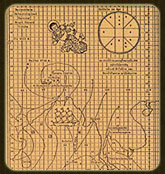
In Mahajanaka, the story emphasizes the importance and value of pure perseverance as a virtue essential for a meaningful life. Readers can also appreciate the detailed maps personally drawn by the King, as well as illustrations created by eight contemporary Thai artists. These artists received direct royal guidance and supervision to ensure that the book’s artistic quality, visual beauty, and illustrative content were of the highest standard, making the work both educational and aesthetically remarkable.
He provided critiques and guidance based on his profound understanding of art, which elevated Mahajanaka into a picture book of exceptional value. The book also serves as a partial record of the visual arts of King Rama IX’s era, marking a return to his cherished passion for painting. Thus, Mahajanaka achieves completeness in language, fine arts, and religious-ethical instruction, demonstrating that King Bhumibol Adulyadej the Great possessed not only extraordinary talent in literature, arts, and social sciences but also remarkable expertise in statistics and astrology, a brilliance inherited from King Chulalongkorn, as noted by Police Major General Suchart Phueaksakorn on April 8, 1998.
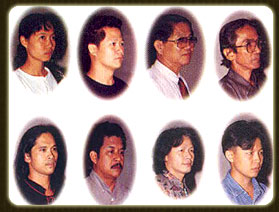
The eight artists (from left to right) are:
Jintana Piamsiri, Chalermchai Kositpipat, Prayad Pongkham, Phichai Niran,
Theerawat Kanama, Preecha Thaothong, Panya Vijinthanasarn, Netikorn Chinyoh.
1. His Majesty the King – Theory of Probability
“On 25 February 1998, at 6:40 p.m., after His Majesty had delivered a royal speech to the royal scholarship students and discussed various other matters for some time, I respectfully raised the rumor about ‘Will the world really end in 2000?’ His Majesty immediately responded, emphasizing that according to the theory of probability, events that have occurred in the past may happen again in the future, but not within a short period; it would require a very long span of time, perhaps eons.”
For example, the city of Varanasi, which existed in the past, may occur again in the future. One event that seems to confirm this is the sinking of His Majesty Mahajanaka’s royal barge, which was echoed in May 1994 when a Thai fishing vessel was wrecked by a cyclone in the Indian Ocean near Bangladesh. The date (lunar day) and location of the incident were remarkably similar. His Majesty even drew the astrological chart indicating the positions of the planets on that day above the illustrations in the royal biography Mahajanaka.
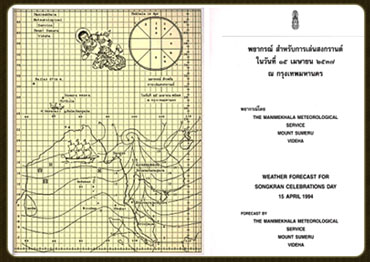
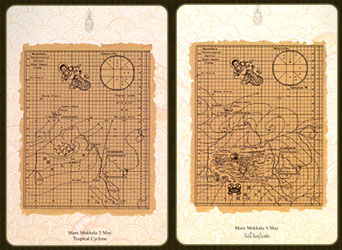
Furthermore, when the royal barge sank, Phra Mahajanaka had to swim with great perseverance for seven days and seven nights to reach the shore. During that time, Lady Mani Mekhala appeared and tested his perseverance until it was proven, after which she helped him and brought him safely to Mithila. In the latter case, the crew members likewise had to swim for several days before being rescued. What is most remarkable is that the Bangladeshi ship coming to their aid was also named Mekhala.
If one were to calculate the time elapsed backward from the sinking of the Thai fishing vessel to the sinking of Phra Mahajanaka’s royal barge, the interval would be extremely long—on the order of tens of thousands of years at minimum—because the account of Phra Mahajanaka is an episode from one of the ten lives of the bodhisattva (the Jataka tales) prior to the historical Buddha’s incarnation as Prince Siddhattha and his eventual enlightenment. If the planets indeed exert influence over human life, animals, plants, weather, and the nature of the world according to astrological doctrine, then on the day Phra Mahajanaka’s royal barge sank there would likely have been at least two planets conjoined or occupying the same position as those the King recorded in the natal chart depicted in the illustrations of the royal composition Phra Mahajanaka—both in terms of degrees and minutes and in declination—for example, Saturn in Aquarius, an air sign, and/or Jupiter in Libra, also an air sign, forming malefic aspects such as right angles (90 degrees) to the Sun and the Moon, and so forth.
Some scientists might contend that this occurrence was more likely coincidental. I therefore present an example I discovered personally as follows.
Seventeen years ago, on 1 April B.E. 2524, a significant event was recorded in Thai history as a political lesson for subsequent generations; among those who witnessed it the day is commonly known as the April Hawaii Rebellion.
The April Hawaii Rebellion occurred at 02:00 hours on 1 April B.E. 2524, when a group of army officers led by Lieutenant General San Chitpatima, Deputy Commander of the Royal Thai Army, staged a coup and seized power from the incumbent government headed by General Prem Tinsulanonda as Prime Minister. The coup leaders established their command at the Army Auditorium and deployed troops to take control of several important sites in Bangkok, including the Radio Thailand broadcasting station, and subsequently issued proclamations and orders through various radio and television stations at intervals.
Radio Thailand served as the central broadcasting network, and since the coup group had seized control of all radio and television stations in Bangkok, they held a clear advantage. The general public could hear news only from the revolutionary side, leading many to believe that the coup had already been successful. In this situation, His Majesty the King, Her Majesty the Queen, and members of the Royal Family proceeded to the headquarters of the Second Army Region in Nakhon Ratchasima Province, at the invitation of Prime Minister General Prem Tinsulanonda. At that time, I was serving as Director-General of the Post and Telegraph Department. Upon learning of the incident, I made the decision—at considerable personal risk—to travel to Nakhon Ratchasima to pay my respects to His Majesty the King. There, I was assigned by General Arthit Kamlang-ek to carry out the technical arrangements for broadcasting the audio from the Second Army Region’s radio station, which served as the government’s main transmitter, to be relayed clearly and effectively through several FM and AM stations of the Post and Telegraph Department (Station 1 P.N.) in Bangkok, comparable in quality to the broadcasts of the revolutionary side. Thus began a psychological warfare between the radio networks of the two opposing factions. Eventually, the various radio stations that had initially relayed the revolutionary broadcasts came to realize the true situation and gradually switched their allegiance to the government side, retransmitting the signal from Station 1 P.N. As a result, both the rebel forces and the general public became fully aware of the actual circumstances.
Therefore, when government troops were airlifted from Nakhon Ratchasima and arrived in Bangkok on the morning of 4 April B.E. 2524, they were able to reclaim the capital without any violent clashes or loss of life. Consequently, the coup led by General San Chitpatima and his associates ended in complete failure.
It is truly remarkable that a similar event is also recorded in Thai historical documents from the late reign of King Taksin the Great, as follows.
… Phraya San led the rebel forces down to Thonburi on the eleventh waning day of the fourth lunar month, in the late part of B.E. 2324, and surrounded the royal palace. On the ninth waxing day of the fifth lunar month, Phraya Suriya Aphai led an army of one thousand Thai and Lao troops from Nakhon Ratchasima to suppress the rebellion. (From “Thai Politics in the Thonburi Period,” by Nidhi Eoseewong, Silpa Wattanatham Special Edition)
This event can be summarized as follows: Phraya San, the leader of the rebellion, and his followers were completely defeated by the forces of Phraya Suriya Aphai, who had marched from Nakhon Ratchasima. Readers are invited to examine the comparison table appended to this article, which contrasts this incident with the April Hawaii Rebellion of 1 April B.E. 2524. From the table, it is evident that the two events occurred exactly 200 years apart.

Apart from this account, there are several other noteworthy events in world history that bear remarkable similarities, all of which serve to affirm the theory that His Majesty King Rama IX once conveyed to me, as mentioned earlier. The only differences lie in the variables used in the calculations, which are unlikely to concern the orbital periods of the planets—such as in the previously mentioned case of the “end-of-the-world” rumor. However, I have not yet had the opportunity to present those examples on this occasion. It therefore remains uncertain whether scientists would still regard such phenomena as mere coincidences.
The royal remarks graciously bestowed upon me clearly reflected His Majesty’s exceptional intellect, profound erudition, and mastery of statistical science—no less remarkable than his expertise in other fields that most of us had never before known or heard of.
(Suchart Phueksakon, Police Major General, His Majesty the King and the Theory of Probability, 1998 [Online]. Available at: http://www.dabos.or.th//ro8.html)
2. His Majesty the King and Astrology — Police Major General Suchart Phueksakon stated:
In the royal literary work Phra Mahajanaka, which His Majesty graciously commanded to be published and distributed, it was found that the illustrations depicting Phra Mahajanaka’s sea voyage—from the day of departure, through the storm that caused the royal barge to sink, to the day Lady Mani Mekhala came to his rescue—each contain a horoscope chart showing the positions of the planets on the corresponding dates (pages 54–57, paperback edition).
As a student of astrology, I could not resist examining these horoscopes, particularly the one for the day when the violent storm arose and caused the royal barge to sink. I studied which zodiac signs the planets occupied at that time as part of my research into the influence of planetary alignments on natural disasters—a field known as Mundane Astrology. The horoscope in question displays the planetary positions as follows:
- The Sun was positioned in Aries.
- The Moon was positioned in Capricorn.
- Mars was positioned in Pisces.
- Mercury was positioned in Aries.
- Jupiter was positioned in Libra.
- Venus was positioned in Taurus.
- Saturn was positioned in Aquarius.
- Rahu was positioned in Scorpio.
- Ketu was positioned in Aries.
- Uranus was positioned in Capricorn.
- Neptune was positioned in Sagittarius.
- Pluto was positioned in Scorpio.
In the royal composition, the date accompanying the horoscope is recorded as May 2, while the year and time of the incident are not specified, as the event took place before the Buddhist Era. The date on which Lady Mani Mekhala came to Phra Mahajanaka’s aid is given as May 9, following his seven days of persevering effort swimming across the ocean.
B.V. Raman, a renowned Indian astrologer, discussed several ways in which planetary influences affect weather patterns. The following excerpt is particularly relevant to wind-related disasters:
“_____South-west winds do result when Jupiter is in Aquarius_______. North-west monsoon winds are ruled by Saturn and South-west by Jupiter. When they are in airy signs the direction of the wind is easily ascertained._____. The air is essentially ruled by the planet which is applying to the Moon after its conjunction, opposition or square with the Sun.____.” (PLANETARY INFLUENCES ON HUMAN AFFAIRS by B.V. Raman)
Translated into Thai and summarized, the essential point is that the planets influencing the strength and direction of storm winds are Saturn, which governs the north-west monsoon, and Jupiter, which governs the south-west monsoon. These effects are most pronounced when the planets occupy the air signs Gemini, Libra, and Aquarius and form major aspects with the Moon or Sun—conjunction (0°), opposition (180°), or square (90°).
Considering the horoscope for the day of the storm in the royal composition, the tropical cyclone that struck on May 2, causing the sinking of Phra Mahajanaka’s royal barge, can be analyzed as follows:
1. Saturn was in Aquarius (an air sign) and Jupiter in Libra (also an air sign). Moreover, Jupiter formed an opposition with the Sun in Aries and a square with the Moon in Capricorn, exactly as noted by astrologer B.V. Raman.
Furthermore, the location where the royal barge sank is near longitude 90°, within the contiguous area between present-day Bangladesh and Myanmar. According to Mundane Astrology, the ascendant of the city of Myanmar is in Libra. The severe storm on that day can thus be attributed to the influence of Jupiter forming an opposition with the Sun and a square with the Moon.
It appears insufficient to consider only the positions of Saturn and Jupiter without also examining the placement of Uranus, which in astrology is regarded as the ruler of accidents. On the day of the incident, Uranus was positioned in Capricorn, the same sign as the Moon, forming a square (90°) with Jupiter. This alignment added an additional malefic influence to Jupiter, making the occurrence of a storm-related disaster inevitable.
2. Another notable point is ” the position of Pluto on the day of the incident, which was conjoined with Rahu—the north lunar node, representing the intersection of the Sun and Moon’s orbits—in Scorpio, a water sign. In astrological interpretation, Pluto signifies “shipwreck.” When positioned near Rahu, which is traditionally believed to cast a shadow affecting the native during conjunctions with the Sun or Moon on the waxing or waning 15th day of the lunar month, it can generate malefic influences over a certain period. It is therefore possible that a lunar or solar eclipse occurred shortly before or after the incident, with the shadow cast reaching the area near Pluto’s position, contributing to the shipwreck. “
“…I have no way of knowing to what extent His Majesty studied this branch of astrology. However, from careful observation of his remarks, I understand the following:
1) His Majesty possessed remarkable skill in astrology. The planetary positions depicted in the horoscopes for the day of Phra Mahajanaka’s voyage in the royal composition Phra Mahajanaka are grounded in scientifically verifiable astrological principles, demonstrating the feasibility and accuracy of their calculation.
2) His Majesty also possessed considerable knowledge of astrology. By analyzing the horoscopes related to Phra Mahajanaka’s voyage, as previously described, I became even more confident that, in addition to his expertise in political science, law, agriculture, engineering, telecommunications, traffic management, irrigation, meteorology, music, sports, and other fields, His Majesty also demonstrated remarkable proficiency in astrology. This proficiency is verifiable through the principles of stellar astrology and is a source of great pride for the Thai people.
However, regardless of the extent of His Majesty’s astrological expertise, I believe that he employed this branch of knowledge only as a supplementary component of his royal judgment in certain matters, much like the early kings of Thailand. This was because His Majesty held a profound and sincere faith in the fundamental teachings of the Buddha and consistently adhered to them in practice. “
(Suchart Phueksakon, Police Major General, M.P.P. [Online]. Available at: http://www.dabos.or.th/datail.html)
2.4.5 The Royal Composition ” Thongdaeng “
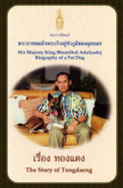
Thongdaeng is the most recent royal composition by His Majesty King Bhumibol Adulyadej. His Majesty reflected that Thongdaeng was an ordinary dog yet extraordinary, widely known and celebrated. Although many stories had been written about Thongdaeng, they often contained inaccuracies and omitted important details—particularly regarding Thongdaeng’s gratitude and devotion to “Mae Mali,” which His Majesty praised as being ” unlike others who, upon attaining status, tend to forget and disregard those of humble origin who had shown them kindness. “
In the royal composition, His Majesty narrates the life of Thongdaeng, one of the dogs he favored, from her birth at the Soi Medical Development Center. The text covers “Khun Nai Thongdaeng,” Thongdaeng’s mother, Thongdaeng’s arrival at the Chitralada Palace grounds, her character, intelligence, loyalty, and gratitude. It also describes her teachings to her puppies, her good manners, special abilities, and her relationship with Thonglang, who was somewhat a rival, along with notes on “Khun Nai Daeng” and “Khun Nai Dang.”
His Majesty King Rama IX’s royal composition Thongdaeng explores philosophical, psychological, and linguistic aspects, as well as employing comedy to offer insights to readers, showing that this dog experiences both positive and negative emotions, such as jealousy, competition, and anger. He emphasized that Thai dogs, even those considered strays, have highly desirable qualities for domestic companionship, and reflected that Thailand has hundreds of thousands of dogs to choose from. With support from government authorities, many people would willingly open their homes to these animals, helping to address the dangers of stray dogs, reduce reliance on expensive pedigree pets that can harm the economy, and promote the development of Thailand’s intelligent, affectionate, and loyal native dog breeds.
This book resembles the royal composition Phra Mahajanaka in that it is presented in both Thai and English. In most of the text, English appears on the left page and Thai on the right. Every illustration is captioned in both languages, with the Thai text on top. This bilingual format is suitable for international readers who read English, as well as for Thai readers who wish to read in Thai and use the English text as a way to practice the language.
Characteristics of the Royal Composition
1) His Majesty uses concise and straightforward language, avoiding unnecessary elaboration, similar to his other royal compositions, including Tito.
2) He conveys humor, for example:
– “… There were four dogs, named according to their color and characteristics:
‘Big Black’ (the local mischievous dog, later neutered)
‘Little Black’ (disappeared after being bullied by Big Black) …” (p. 15)
– “… Big Black had to be neutered because he brazenly courted two female Golden Retrievers in the village, resulting in fifteen all-black Golden Retriever puppies (9 + 6), forming the ‘Big Black’ line of Labradors, much to the owner’s frustration …” (p. 15)
– “… Therefore, ‘Daeng’ and all her puppies were fully transformed from municipal dogs into true domestic dogs …” (p. 23)
– “… Thongdaeng was larger than a Basenji, so he was called the ‘Thai Super Basenji’ …” (p. 32)
– “… His Majesty had an audience that lasted a bit too long. When it was time to leave, Thongdaeng, who had been standing at a distance, walked forward and licked His Majesty’s hand several times. Observing this, His Majesty remarked to the attendants, ‘Thongdaeng has come to see me off.’ …” (p. 41)
– “… After applying powder all over, Thongdaeng got up, walked a few steps, and scratched again. His Majesty then said, ‘Thongdaeng, you’ve had the powder; you shouldn’t be itchy anymore.’ Thongdaeng believed him and actually stopped scratching …” (p. 42)
– “… When His Majesty would say, ‘Thongdaeng, take care of this,’ Thongdaeng would immediately nip the puppy’s leg, pull it out, growl, and lightly bite its mouth as a warning until the puppy submitted. He did this with every puppy that strayed from the line …” (p. 63)
– “… When showing loyalty, Thongdaeng would lick His Majesty’s hand vigorously and for a long time, what His Majesty called ‘serious licking,’ meaning with full intent …” (p. 69)
3) His Majesty imparted teachings that ordinary people could apply to cultivate goodness following Thai cultural values, for example:
– “… Sometimes Mae Mali taught Thongdaeng to fetch sticks (at three months old). Later, when they were apart and met again, Thongdaeng still showed respect to ‘Mae Mali,’ unlike others who, upon becoming important, often lose humility and look down on those of humble origin …” – teaching gratitude (p. 57)
– “… Being favored by His Majesty did not make Thongdaeng arrogant or boastful; on the contrary, he remained respectful and did not threaten anyone …” – teaching proper manners (p. 71)
4) His Majesty also provided knowledge of canine psychology, demonstrating a deep understanding of Basenji behavior and how to care for them, recorded on pages 22, 27, and 29. He was recognized as the foremost expert on Basenjis in Thailand, as noted on pages 24–25 in both the Thai and English sections.
5) Reading the English text alongside the Thai provides a richer experience, for example:
– “… แสดงว่าทองแดงมีส่วนผสมสุนัขหลายพันธุ์เช่นเดียวกับ “ สุนัขพันธุ์ทาง ” ทั้งหลาย …” (หน้า 32)
“…It means that Tongdaeng is a mixture of many breeds of dogs, a truly “ thousand ways mixed mid-road dog ” …”
Additionally, readers can learn English phrases and vocabulary that convey precise meanings, which are often difficult to find even in standard dictionaries, such as:

This hardcover book has 84 pages, with beautifully colored illustrations on every page. It is a book that nearly every Thai household owns, both for reading and as a symbol of good fortune, featuring a portrait of His Majesty the King on the cover and multiple royal portraits inside. Thongdaeng was first published in November 2002 with 100,000 copies and has since been reprinted several times in batches of 100,000 copies, with orders from both domestic and international readers. It is considered one of the highest-selling books in the world in terms of daily sales, with some days seeing more than ten thousand copies purchased.
3. Athletic Genius
His Majesty King Rama IX had a deep interest in and fondness for sports from a young age, appreciating activities that required strength, skill, agility, and the application of knowledge and overall abilities. He enjoyed skiing, sailing, rowing, shooting, badminton, go-karting, mini-golf, as well as jogging, brisk walking, and cycling.
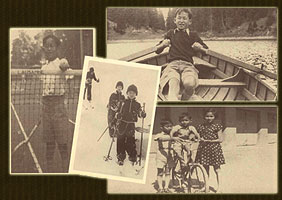
On every occasion, His Majesty exercised in strict accordance with the principles of sports science, meticulously monitoring his pulse and blood pressure before and after physical activity. He continually studied how to begin exercises properly, how to warm up, and how to relax and relieve muscle tension afterward. In this way, he exemplified the ideal model of a true athlete.

In His Majesty King Rama IX’s sports pursuits, he did not favor purchasing expensive equipment, especially in sailing, which he was particularly passionate about. He personally built his boats with meticulous craftsmanship, adhering to international standards. Studying plans and regulations for each type of boat from texts around the world, the boats he constructed were highly refined and complete. The first boat he built by hand was an Enterprise, the second was a two-person Enterprise named “Rajapat,” and the third was an O.K. boat named “Waka,” which he favored greatly.

He launched the boat “Rajapat” from the royal residence.

His Majesty King Rama IX, as the Head of State of Thailand, was the first monarch to participate in national-level international sports competitions. He competed in shooting, badminton, and sailing, with a particular fondness for sailing. On the occasion when Thailand was honored to host the 4th Southeast Asian Peninsular Games from December 9–16, 1967, His Majesty personally applied for selection as a sailor.
Through His Majesty’s skill and dedication, he was selected as a national team athlete, received allowances, and attended training camps according to the same programs as other athletes. During the 4th Southeast Asian Peninsular Games, His Majesty King Rama IX and Her Royal Highness Princess Ubolratana Rajakanya competed in sailing, held at Pattaya Bay, Bang Lamung District, Chonburi Province. The second sailboat he used in the competition was personally crafted by him at the Chitralada Royal Shipyard. Whenever His Majesty had free time from royal duties, he would design small sailboats, one of which he named “Super Ant,” a lightweight vessel suitable for smaller competitors and easy to transport.

He sailed the Super Mod boat.
Lieutenant General Udom Sutthasna Na Ayudhya and colleagues, writing in the Navy Journal on March 1, 1967, described the boat as follows:
“The Mod boat has a total length of 11 feet, a width of 4–5 feet, and a draft of 4–6 inches. Its sail area ranges from 72–82 square feet. It uses a daggerboard, a centerboard that moves vertically, made of wood or metal, with dimensions that may vary.”

With their exceptional skill, His Majesty King Bhumibol Adulyadej and Her Royal Highness Princess Ubolratana won first place, and during the closing ceremony at Suphachalasai Stadium, National Stadium, Her Majesty the Queen presented the first-place medal to His Majesty and awarded a medal to Her Royal Highness Princess Ubolratana, delighting the Thai people and demonstrating their abilities to the world.
The Cabinet resolved to designate December 16 of every year as National Sports Day, with the Sports Authority of Thailand coordinating both public and private sectors to hold nationwide celebrations annually, honoring and commemorating His Majesty’s athletic excellence and following in his footsteps. His Majesty often expressed that “a good athlete must be patient, disciplined, have proper planning, and consistently strive for self-improvement.”
His Majesty’s benevolence toward sports emphasized that each sport requires cooperation and dedication from participants and athletes alike. Traditionally, clubs or sports associations are established to manage and promote each sport continuously.
His Majesty King Bhumibol Adulyadej established his personal club, the Royal Chitralada Yacht Squadron (RCYS), and also patronized other clubs such as the Royal Waruna Club at Pattaya Bay, the Boat Club of the Naval Academy, the Naval Fleet Club, the Marine Corps Club, the Sattahip Naval Station Club, and the Naval Dockyard Club. These clubs, with various types of sailing boats for competition, helped advance and develop sailing in Thailand, producing athletes capable of competing not only nationally but also internationally.
His Majesty devoted time to study and personally practice national sports activities so that the Thai people could follow in his footsteps. He also graciously extended royal patronage to the National Olympic Committee of Thailand and 11 amateur sports associations, including:
- Amateur Athletic Association of Thailand
- Badminton Association of Thailand
- Basketball Association of Thailand
- Football Association of Thailand
- Judo Association of Thailand
- Lawn Tennis Association of Thailand
- Rugby Football Union of Thailand
- Shooting Sports Association of Thailand
- Thai Sports Association
- Sailing Association of Thailand
- Amateur Boxing Association of Thailand
His Majesty King Bhumibol Adulyadej recognized sports as a source of national unity and a means to strengthen both the body and mind of his people, and thus actively promoted and supported national sports through various actions.
During a royal visit to the southern provinces in 1959, He observed the traditional boat races in the Chuk Phra festival of Surat Thani province.
In 1965, He watched boxing competitions at Ratchadamnoen Boxing Stadium, where proceeds were contributed to the Ananda Mahidol Foundation.
In 1967, His Majesty, accompanied by Her Majesty Queen Sirikit, presided over the opening ceremony of the 4th Southeast Asian Peninsular Games at the National Athletics Stadium, and also attended the closing ceremony.
In 1970, He presided over the traditional inter-university badminton competition among Thammasat University, Kasetsart University, Mahidol University, Chiang Mai University, Khon Kaen University, and Chulalongkorn University.
He also lit the ceremonial torch for the 6th Asian Games from December 9–12, 1970, at Chitralada Royal Palace, granting an audience to the President of the Asian Games Federation, committee members, and 252 Thai athletes to receive royal guidance at Phakphiram Pavilion.
On December 9, 1970, He officiated the opening ceremony of the games.
In 1971, His Majesty granted an audience to the President of the National Olympic Committee of Thailand and 324 athletes and officials traveling to the 6th Southeast Asian Peninsular Games in Kuala Lumpur, Malaysia, to offer farewell and receive royal guidance.
His Majesty King Bhumibol Adulyadej’s royal activities have been recognized and acclaimed worldwide. At the 92nd Session of the International Olympic Committee held in Istanbul, Turkey, with Mr. Juan Antonio Samaranch presiding and representatives from 87 countries attending, it was unanimously resolved to confer upon His Majesty the IOC’s highest honorary award, the Olympic Order in Gold, on December 14, 1987, at Dusit Palace, Chitralada Royal Residence. He became the first monarch in the world to receive this honor.
Later, at the 195th meeting of Mahidol University Council on May 15, 1991, it was unanimously resolved to confer upon His Majesty an Honorary Doctorate in Sports Science, which was officially awarded on August 8, 1991.
From His Majesty’s outstanding abilities and royal accomplishments, King Bhumibol Adulyadej stands as both a sovereign and an exceptional athlete, a source of pride for all Thai people, who always remember Him as the inspiration and heart of Thai sports. (Excerpted from Sansanee Chanthawong, “The Monarch-Athlete,” Daily News, December 5, 1999, p.17)

